

Cambridge C1 Advanced (CAE): How to Write a Proposal
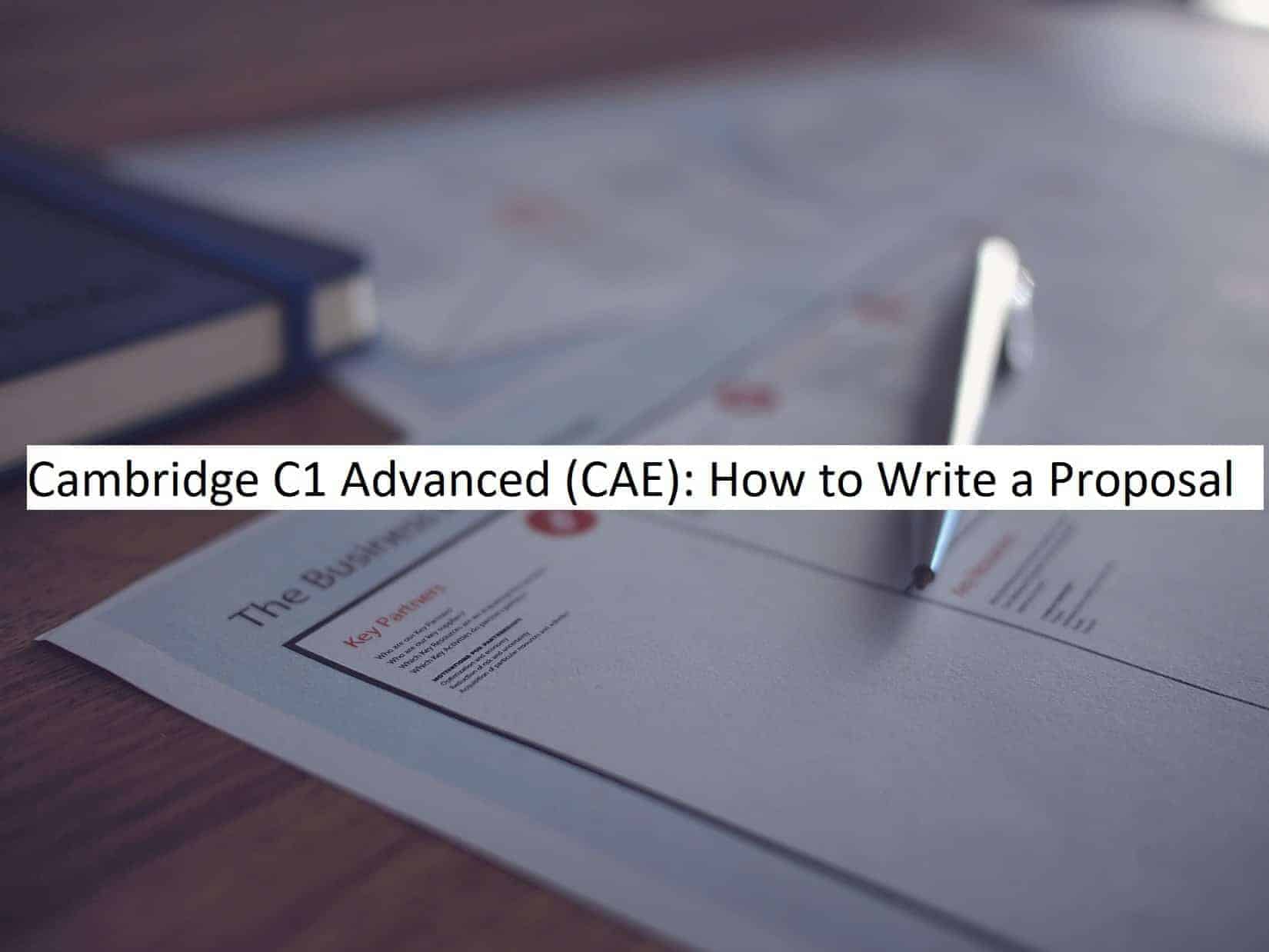
Get Your Free C1 Advanced Writing Cheat Sheet Now!
Just leave your name and email address below.
Please check your email inbox and spam folder for your free PDF.
Introduction
A proposal may be written for a peer group (such as colleagues or club members), or for a supervisor (such as a boss or a college principal). Candidates will be expected to make one or more suggestions, supported by factual information and evaluation, in order to persuade the reader of a course of action. Students should work on functional language for evaluating and for making suggestions, and will need to be able to use a range of persuasive language. Source: Cambridge English C1 Advanced handbook for teachers
Proposals are part of the section section of the C1 Advanced Writing paper. While the essay task in the first section is mandatory, you can choose if you want to write a proposal or not as you get other options ( email/letter , review , report ).
What a proposal really is
I’ve seen many students who get a little bit scared when it comes to writing a proposal for C1 Advanced. They’ve often finished their B2 First course and/or exam and the problem really is that there are no proposal writing tasks in FCE . So, the whole idea of proposals is new to them and the unknown generally scares us.
However, proposals are a lot simpler and more straightforward than you might think. In fact, they are fairly similar to reports , but we’ll get into that a bit later in this post. My point is that there is a certain structure that all proposal tasks follow, which gives you an opportunity to exploit them and get great marks.
Long story short, I’m going to show you a typical task and we will dissect it together in order to give you the insight and tools you need to crush it when you sit down to write CAE proposals so let’s get it.
What a typical proposal task looks like
As I said in the previous section, proposal tasks usually look very similar, which means that you can take advantage of certain characteristics. Here is what a task might look like:

In all of these tasks (and every writing task in C1 Advanced, really) there are two things you need to ask yourself before you even start to make a plan:
- What do I have to include in my proposal?
- Who is going to read it?
Always read the task very carefully and underline the things you are required to write about (hint: there are usually three 😉 ).

The three topic points we need to consider are now nicely highlighted:
- Why should the building be preserved?
- What could be done to modernise it?
- How could the building benefit the local people?
Of course, you should also think of a specific building to write about, but I’m sure that you can come up with an old factory or something like that around where you live quite easily. If you reside in a hyper-modern area, just make up a building or think of Hogwarts or something like that 🙂 .
The second question for you to consider is who’s going to read your proposal. You might ask yourself why this is important in the first place, but it tells you if you should use formal, neutral or informal language.
In our example task you have to write to the town council, which means that it’s a pretty official proposal. For this reason, formal English is the way to go.
In formal English – and for the purpose of doing the CAE exam – there are a couple of rules that you should follow: no contractions ( I’m , don’t , etc.), no colloquial expressions ( Hey, what’s up? , I liked it heaps ., etc.), and no slang or phrasal verbs that convey informality ( I’m bursting vs. I have had enough to eat; carry on vs. continue).
This can vary slightly from task to task. For example, if you are writing for your classmates, you can be a little bit more informal, but, generally speaking, you should always be polite. use your common sense and you’ll be fine.
How to organise your proposal
In this part we are going to look at the structure of a proposal. The good thing is that this organisational pattern works for every proposal you’re going to write on your C1 Advanced journey so you can practise and improve very easily and gain the confidence you need to be great.

I hope you remember the three topic points from our example.
I guess it makes perfect sense to give each of those three points a separate paragraph. Add to this a title/introduction and a conclusion / final sentence and we’re at five. Putting everything together it looks like this:
- Title/introduction
- Conclusion / final sentence
In proposals we also give each section a heading, which makes it very similar to a report. The big difference is, however, that a report makes recommendations based on past events while a proposal talks about something that hasn’t happened yet.
This structure can be applied to every single proposal writing task and it should give you the confidence to get started.
Always make a plan before you start writing
This one drives me crazy. I see it all the time that students give me their writing tasks and I find that certain topic points are not covered or the organisational structure is chaotic and all over the place. The reason is almost always lack of planning, which is just mind-boggling to me as it only takes a few minutes to come up with a little list of bullet points and some ideas.
Please don’t make the same mistake. Always make a plan before you start writing. It can save you a love of time and headaches because everything you need is right there in front of you so you can focus on good content and language .
The different parts of a proposal
In this part we are going to look at the example from the beginning of this post again and I’m going to walk you through writing a proposal step by step so you know exactly how this whole thing works. Of course, the topic changes from task to task, but if you understand the essence, you will be able to apply this knowledge to every future task.
A proposal is a rather factual and informative piece of writing so it is not your job to make it sound happy or sensational (as you would in a review or possibly an informal email). Therefore, your introduction should get straight to the point. Say what the proposal’s purpose is and what you are going to include. It is also important to note that you should never just copy the words from the task, but paraphrase them and use your own words instead.
Some useful language for an introduction includes (but is not limited to) the following phrases:
- The purpose/aim of this proposal is to …
- The proposal is intended to show/discuss/suggest/outline …
- In this proposal I will …
Let’s have a look at a possible example:
Proposal to modernise the old brewery Introduction This proposal is intended to outline why the old brewery on ABC Street should not be demolished and is worth protecting, how it could be turned into a valuable asset for the town and in what ways it could be of use for the residents of the town.
You see that the intro doesn’t have to be very long or detailed. What I have done is that I simply followed my own advice stating the purpose of the proposal and explaining what is included paraphrasing the task. That’s it.
Topic paragraphs
In your topic paragraphs you deal with the three different main points from the task. As mentioned above, you are not required to make this sound sensational, but rather informational and factual.
At the same time, however, you’re trying to convince the local council to consider your proposal so you need to use language to make suggestions and to be persuasive .
As we said earlier, your paragraphs should get headings so it becomes evident very easily what you are talking about in each section.
The brewery as an opportunity The old brewery building with its central location and unique architecture is still a focal point of the town centre for many people . While it has not been in use for some years, everyone has fond memories of the annual summer celebration. Therefore, it would be very sad to simply demolish the building when there is an opportunity just waiting to be taken. How to modernise it It is apparent that the modernisation of a building this old can be a challenge as everything from the ground up needs renovating. However, some of our local architects would be willing to work together and develop a design that takes into account the financial constraints of the public budget as well as environmental factors. I strongly recommend turning the brewery into a co-working space so the rent will offset some of the costs and give our town a modern touch on a historic site. It benefits everyone in town If the council decides to follow my suggestions, there will be great benefits for everybody involved. The town would create another source of income, the space would attract creative professionals and not only would it benefit them, but local residents would also be able to keep their beloved brewery in the town centre.
In these three paragraphs you can find everything that’s important when writing a proposal for C1 Advanced. There are clear headings that tell the reader what to expect in each section of the text and I used some persuasive language which I highlighted for you. Obviously, there are tons of expressions that you can include, but the list is too long for this post. I’m sure, however, that you get the idea.
Last but not least, we need a nice and short conclusion to give a last recommendation. Make sure that you try to convince the reader of your idea one more time.
Conclusion In my opinion, the brewery should be modernised and turned into a co-working space, and I strongly urge the council to consider this proposal.
Nothing fancy, just straight to the point giving your opinion and pushing the issue again.
If you put all the different parts together, you’ll get a solid proposal that ticks all the boxes in terms of structure, language and ideas. The examiner will be happy and you’ll get high marks.
Time to practise
Now it is up to you to get started. You can find a lot of example tasks in books or online so practise as much as you can to become more familiar and more confident with proposals.
Lots of love,
Teacher Phill 🙂
Similar Posts
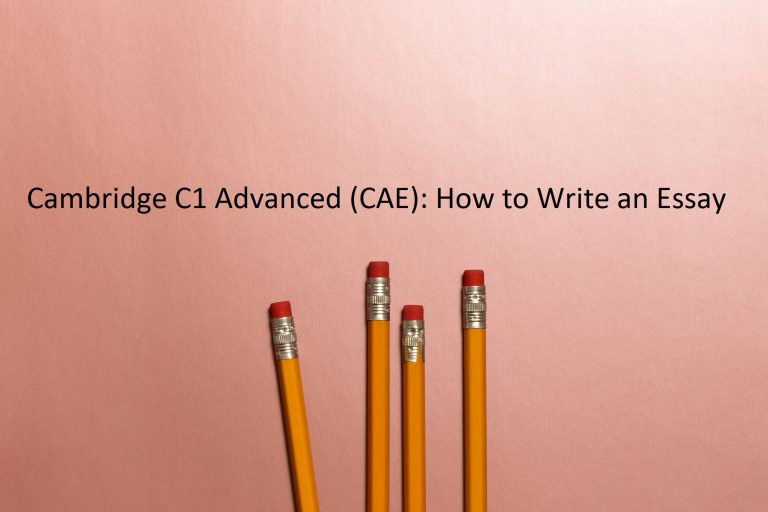
Cambridge C1 Advanced (CAE): How to Write an Essay
Get Your Free C1 Advanced Writing Cheat Sheet Now! Just leave your name and email address below. Yes, I want…

Cambridge C1 Advanced (CAE): Reading and Use of English Part 3

Cambridge C1 Advanced (CAE): How Your Writing is Marked
Introduction One of the more complicated things about C1 Advanced is definitely how your writing tasks are marked. I get…

Reading Skills – 7 Great Tips To Improve
Table of Contents Do You Have Problems With Your Reading Skills? If you’ve come to this article, I guess that…

Cambridge C1 Advanced (CAE): How to Write an Email/Letter

Cambridge C1 Advanced (CAE): Reading and Use of English Part 5

- How to write a C1 Advanced Report/Proposal

- Posted on 16/11/2022
- Categories: Blog
- Tags: CAE , Cambridge Exams
Are you preparing for the Cambridge C1 Advanced exam and need a hand with writing your report/proposal for Part 2 of the Writing paper? Perfect! You’re in the right place.
By the end of this blog post, you’ll know exactly what the C1 reports and proposals are, how to structure them perfectly and what you need to do to get top marks in your exam.
Before we get started, if you’re looking for some help with Part 1 of the C1 Writing paper, check out our blog post here on how to write the perfect essay.
What is a Cambridge C1 Advanced report?
The objective of a report is to present factual information (you can invent the facts, but they must be presented as factual) and evaluate to what extent a particular aim has been achieved or make suggestions to improve something that has already happened.
Your reader may be a superior (such as a boss or school headmaster) or a peer group (such as club members or colleagues).
What is a Cambridge C1 Advanced proposal?
The objective of a proposal is to persuade your reader to take a particular course of action by making suggestions , supported by factual information (again, you can invent this).
Your reader may be a supervisor (such as a boss or school headmaster) or for a peer group (such as colleagues or club members).
So far, the report and proposal both sound pretty similar, don’t they? They are! However, there’s just one key difference between the two.
What is the difference between a report and a proposal?
Your report will always be written about something that has already happened . You will need to reflect and give your opinions and suggestions on how something from the past can be improved.
However, your proposal will always be written about the future and normally you will need to persuade your reader to take a particular course of action .
Three steps to write the perfect Cambridge C1 Advanced report/proposal
Reports and proposals follow exactly the same structure. To keep things simple, let’s just focus on an exam question for a report. You can practise analysing and writing a proposal later!
Step 1: Plan it
Let’s take a look at the exam question below.

Source: https://www.cambridgeenglish.org
First things first , you need to identify the topic of the report (this is underlined in blue below) as this will tell you exactly what you need to write. At this point, start thinking of the vocabulary and expressions you can use.

Next, you need to identify who your reader is. In this case, it’s the programme organiser, so you need to write in a formal style.
Lastly, you need to identify exactly what you need to include in your report. There are usually two or three points/questions to answer (these are underlined in orange below).

Now you know the topic, the questions you need to include, and who the reader is, it’s time to start writing!
Step 2: Write it
Your report/proposal must include a title, an introduction, topic paragraphs with subheadings and a conclusion.
Take a look at the example answer below.

This student has given their report a clear title.
In their introduction, they have stated the purpose of their report, which prepares the reader for what they are going to read in the following topic paragraphs.
The topic paragraphs all have subheadings and address each of the three key points from the exam question.
Finally, the conclusion gives suggestions to the reader on the improvements they can make on the programme.
Step 3: Check it
Now that you’ve written your text, it’s time to check it! A lot of students often skip this step, but make sure to give yourself at least 10 minutes to check your writing.
Here’s a quick checklist of things to look out for :
- Have you done what the task asked you to do and kept everything relevant?
- Is your tone, register, style and vocabulary appropriate?
- Is your writing clearly connected, logical and ordered?
- Have you accurately used a good range of spelling and vocabulary?
- Have you checked your spelling, grammar and punctuation?
Top tips and advice
- You have 90 minutes in total for the writing exam.
- For Part 2, use 10 minutes to plan , 25 minutes to write and 10 minutes to check .
- Your word count is between 220 and 260 . Don’t go too much over or under this as you’ll get penalised .
- Remember to plan! Plan the structure as well as the grammar and vocabulary you can use. Think ‘where can I use inversion?’, ‘what connectors can I use?’, ‘what C1 vocabulary can I use for this topic?’ and so on.
Time to practise your writing
Now it’s time for you to have a go at practising your writing skills!
Take a look at the exam question below for a proposal. Follow the same steps above. Just remember to write it for the future .

Here’s an example answer for you.

Looking for further help with your C1 Advanced exam preparation?
If you’re looking for feedback on your writing and further guidance, why not check out our exam preparation courses ? Our classes are dynamic and practical and our friendly professional teachers will help you get the score you need.
Glossary for Language Learners
Find the following words in the article and then write down any new ones you didn’t know.
Need a hand with (id): to need help with something.
Course of action (ph): a way of proceeding.
First things first (idiom): to tell someone that there are more important things to be done first.
Skip (v): to pass something without mentioning.
Look out for (pv: to try to notice.
Penalise (v): to punish someone for breaking a rule.
Have a go at (pv): make an attempt.
ph = phrase
pv = phrasal verb
Leave a Reply
Name (required)
Email (required)
5 of the best apps to improve your English listening skills
- Posted on 02/11/2022
5 Interesting Christmas traditions from around the world
- Posted on 07/12/2022
Related Post

A Guide to English Accents Aro
Countries can have extremely different English accents despite sharing the same language. Just take the word ‘water’... Read More

Passing Cambridge C2 Proficien
Many sections of the Cambridge Proficiency are multiple-choice, so Part 2 of the Reading and Use of English can seem cha... Read More

Exploring the Impact of AI in
Gone are the days of learning from phrasebooks and filling in worksheets for homework. Now students have access to a wid... Read More

Everything You Need To Know Ab
Although you learn plural nouns early on, they can be challenging. There are many rules and exceptions to remember plus ... Read More

The Importance of English For
No matter where you live, you’ve probably experienced record-breaking temperatures and severe weather. You may have se... Read More

Discovering Barcelona Through
We all know that Barcelona is a fantastic city to live in. You only need to spend the afternoon wandering around one of ... Read More

8 New Words To Improve Your Vo
The arrival of a new year presents an ideal opportunity to work on your language goals. Whether you’re preparing for a... Read More

Learning English through Chris
It’s beginning to look a lot like Christmas! If you resisted the urge to sing that line instead of saying it, then, we... Read More

24 Christmas Phrases for Joyfu
‘Tis the season to be jolly, and what better way to get ready for the festive period than by learning some typical Chr... Read More

3 Easy Ways To Use Music To Im
Are you ready to embark on your latest journey towards mastering the English language? We all know that music is there f... Read More

Grammar Guide – Understandin
Do you sometimes feel a bit lost when deciding which tense to use? Are you a little unsure of the differences between th... Read More

Halloween Humour: Jokes, Puns
We all need a break from time to time. Sometimes we’re up to our eyeballs in projects at work, and we just need a mome... Read More

English for Business: 7 Ways L
If you’re interested in getting a promotion at work, earning a higher salary or landing your dream job, then working o... Read More

A Beginner’s Guide to Ch
Understanding the need for exams An official exam is a fantastic way to demonstrate your English. Why? Firstly,... Read More

English Tongue Twisters to Imp
One of the most fun ways to practise and improve your pronunciation is with tongue twisters. That’s because they’re ... Read More

25 years of Oxford House – O
We all know that fantastic feeling we have after completing an academic year: nine months of English classes, often twic... Read More

Guide to the Cambridge C2 Prof
Are you working towards the Cambridge C2 Proficiency (CPE) exam? Have you been having sleepless nights thinking about wh... Read More

9 Tips For Communicating With
When travelling to or living in an English-speaking country, getting to know the local people can greatly enhance your e... Read More

Are you preparing for the Cambridge C2 Proficiency (CPE) writing exam? If those pre-exam jitters have started to appear,... Read More

English Vocabulary For Getting
Are you feeling bored of the way your hair looks? Perhaps it’s time for a new you. All you need to do is make an appoi... Read More

5 Spelling Rules For Comparati
Messi or Ronaldo? Pizza or sushi? Going to the cinema or bingeing on a series at home? A beach holiday or a walking trip... Read More

Are you preparing for the Cambridge C2 Proficiency (CPE) writing exam? If so, you may be feeling a little nervous and co... Read More

Improve your English pronuncia
What are some of the trickiest words to pronounce in English? Well, we’ve compiled a useful list of ten of the most di... Read More

Using Language Reactor To Lear
If you love watching Netflix series and videos on YouTube to learn English, then you need to download the Language React... Read More

Are you preparing for the Cambridge C2 Proficiency (CPE) exam? Would you like to know some tips to help you feel more at... Read More

How to use ChatGPT to practise
Are you on the lookout for an extra way to practise your English? Do you wish you had an expert available at 2 a.m. that... Read More

Well done. You’ve been moving along your English language journey for some time now. You remember the days of telling ... Read More

Tips for the IELTS listening s
Are you preparing for the IELTS exam and need some help with the listening section? If so, then you’ll know that the l... Read More

7 new English words to improve
A new year is a perfect opportunity to focus on your language goals. Maybe you are working towards an official exam. Per... Read More

How to Write a C1 Advanced Ema
Did you know that there are two parts to the C1 Advanced Writing exam? Part 1 is always a mandatory . Part 2 has ... Read More

5 Interesting Christmas tradit
When you think of the word Christmas, what springs to mind? For most people, it will be words like home, family and trad... Read More

5 of the best apps to improve
Would you like to improve your English listening skills? With all the technology that we have at our fingertips nowadays... Read More

Tips for the IELTS Reading sec
Looking for some tips to get a high band score in the IELTS Academic Reading exam? If so, then you’re in the right pla... Read More

The 5 best Halloween movies to
Boo! Are you a fan of Halloween? It’s that scary time of year again when the creepy creatures come out to play, and th... Read More

How to Write a Review for Camb
Are you planning to take the Cambridge C1 Advanced (CAE) exam? If so, you will need to complete two pieces of writin... Read More

How To Use Relative Pronouns i
Today we’re taking a look at some English grammar that sometimes trips up language learners. In fact, we’ve just use... Read More

How To Get Top Marks: Cambridg
So you’re taking the ? If so, you’ll know that you have four sections to prepare for: speaking, reading and use of E... Read More

Travel Vocabulary To Get Your
Summer is here and we can’t wait to go on our summer holidays! If you’re thinking about travelling overseas this yea... Read More

How To Get A High Score In The
So you’re preparing for the ! From wanting to live and work abroad to going to university in an English-speaking count... Read More

10 English Idioms To Take To T
Is there anything better than cooling off in the sea on a hot summer’s day? Well, if you live in Barcelona you hav... Read More

Tips for IELTS speaking sectio
Are you preparing for the IELTS test? If so, you’ll need to do the speaking section. While many people find speaking t... Read More

How to use 6 different English
Just when you think English couldn’t get any more confusing, we introduce you to English pronouns! The reason why peop... Read More

How to get top marks: B2 First
Congratulations – you’ve made it to the B2 First Reading and Use of English Part 7! Yet, before we get too excited, ... Read More

5 Of The Best Apps For Improvi
Speaking is often thought to be the hardest skill to master when learning English. What’s more, there are hundreds of ... Read More

Do you like putting together puzzles? If so, your problem solving skills can actually help you with B2 First Reading and... Read More

8 Vocabulary Mistakes Spanish
If you ask a Spanish speaker what they find difficult about English language learning, they may mention false friends an... Read More

How To Get Top Marks: B2 First
Picture this: You’re in your B2 First exam and you’ve finished the Use of English part. You can put it behind you fo... Read More

12 Business Phrasal Verbs to K
Want to improve your English for professional reasons? You’re in the right place. When working in English, it’s comm... Read More

How to use articles (a, an, th
Knowing what articles are and when to use them in English can be difficult for language learners to pick up. Especially ... Read More

Are you preparing for ? Reading and Use of English Part 4 may not be your cup of tea – in fact most students feel quit... Read More

Passing B2 First Part 3: Readi
Are you studying for the B2 First exam? You’re in the right place! In this series of blogs we want to show you al... Read More

8 new English words you need f
New words spring up each year! They often come from popular culture, social and political issues, and innovations in tec... Read More

7 of the Best Apps for Learnin
If you find yourself commuting often and spending a lot of time on the bus, you’ll most likely turn towards playing ga... Read More

The B2 First is one of the most popular English exams for students of English. It is a recognised qualification that can... Read More

4 Different Types Of Modal Ver
What are modal verbs? They are not quite the same as regular verbs such as play, walk and swim. Modal verbs are a type o... Read More

So you’ve decided to take the ! Formerly known as FCE or the First Certificate, this is by far most popular exam. Whe... Read More

Useful Expressions For Negotia
A lot of our global business is conducted in English. So, there’s a strong chance you may have to learn how to negotia... Read More

Passing C1 Advanced Part 8: Re
If you’re wondering how to do Part 8 of the Reading and Use of English paper, you’re in the right place! After s... Read More

The Difference Between IELTS G
You’ve probably heard of . It’s the world’s leading test for study, work and migration after all. And as the world... Read More

Passing C1 Advanced Part 7: Re
Welcome to Part 7 of the Reading and Use of English paper. This task is a bit like a jigsaw puzzle. One where you have ... Read More

The Benefits Of Learning Engli
Who said learning English was just for the young? You're never too old to learn something new. There are plenty of benef... Read More

So, you’re preparing to take the . You’ve been studying for each of the four sections; reading, writing, speaking an... Read More

6 Reels Accounts to Learn Engl
Are you looking for ways to learn English during the summer holidays? We’ve got you covered – Instagram Reels is a n... Read More

Passing Cambridge C1 Advanced
Well done you! You’ve made it to Part 6 of the Reading and Use of English exam. Not long to go now – just three mor... Read More

8 Resources To Help Beginner E
Learning a new language is hard, but fun. If you are learning English but need some help, our monthly course is what y... Read More

5 Famous Speeches To Help you
Everyone likes listening to inspiring speeches. Gifted speakers have a way of making people want to listen and take acti... Read More

How To Write A B2 First Formal
Dear reader… We sincerely hope you enjoyed our previous blog posts about the Writing section of the B2 First. As promi... Read More

4 Conditionals In English And
Conditionals? Is that something you use after shampooing your hair? Not quite. You may have heard your English teacher t... Read More

After racing through the first four parts of the Cambridge English Reading and Use of English paper, you’ve managed t... Read More

7 Of The Best Apps For Learnin
There are roughly 170,000 words in use in the English language. Thankfully, most native English speakers only have a voc... Read More

How to write a B2 First inform
You're probably very familiar with sending emails (and sometimes letters) in your first language. But how about in Engli... Read More

How can I teach my kids Englis
Keep kids’ minds sharp over the Easter holidays with some entertaining, educational activities in English. There are l... Read More

How Roxana went from Beginner
Roxana Milanes is twenty five and from Cuba. She began English classes back in May 2019 at Oxford House, and since then ... Read More

4 Future Tenses In English And
“Your future is whatever you make it, so make it a good one.” - Doc Brown, Back to the future. Just like the and... Read More

10 Business Idioms For The Wor
Business idioms are used throughout the workplace. In meetings, conversations and even whilst making at the coffee mac... Read More

5 Tips For Reading The News In
We spend hours consuming the news. With one click of a button we have access to thousands of news stories all on our pho... Read More

How To Write a Report: Cambrid
Imagine the scene. It’s exam day. You’re nearly at the end of your . You’ve just finished writing Part 1 - , and n... Read More

8 English Words You Need For 2
Back in December 2019, we sat down and attempted to make a list of . No one could have predicted the year that was about... Read More

5 Christmas Movies On Netflix
Christmas movies are one of the best things about the holiday season. They’re fun, they get you in the mood for the ho... Read More

MigraCode: An Inspiring New Pa
Oxford House are extremely proud to announce our partnership with MigraCode - a Barcelona-based charity which trains ref... Read More

The Ultimate Guide To Video Co
The age of telecommunication is well and truly here. Most of our business meetings now take place via video conferencing... Read More

6 Pronunciation Mistakes Spani
One of the biggest challenges for Spanish speakers when learning English is pronunciation. Often it’s a struggle to pr... Read More

6 Ways You Can Learn English w
“Alexa, what exactly are you?” Alexa is a virtual AI assistant owned by Amazon. She is voice-activated - like Sir... Read More

Passing Cambridge C1 Advanced:
Okay, take a deep breath. We’re about to enter the danger zone of the Cambridge exam - Reading and Use of English Par... Read More

What’s new at Oxford House f
Welcome to the new school year! It’s great to have you back. We’d like to remind you that , and classes are all st... Read More

European Languages Day: Where
The 26th of September is . It’s a day to celebrate Europe’s rich linguistic diversity and show the importance of lan... Read More

Back To School: 9 Tips For Lan
It’s the start of a new academic term and new courses are about to begin. This is the perfect opportunity to set your ... Read More

How to Maximise Your Online Co
If there’s one good thing to come out of this year, it’s that learning a language has never been so easy or accessib... Read More

How To Learn English With TikT
Are you bored of Facebook? Tired of Instagram? Don’t feel part of the Twitter generation? Perhaps what you’re lookin... Read More

A Brief Guide To Different Bri
It’s a fact! The UK is obsessed with the way people talk. And with , it’s no surprise why. That’s right, accents a... Read More

Study English This Summer At O
Summer is here! And more than ever, we’re in need of a bit of sunshine. But with travel restrictions still in place, m... Read More

5 Reasons To Learn English Out
As Barcelona and the rest of Spain enters the ‘new normality’, it’s time to plan ahead for the summer. Kids and te... Read More

5 Free Online Resources For Ca
Are you preparing for a Cambridge English qualification? Have you devoured all of your past papers and need some extra e... Read More

6 Different Uses Of The Word �
The word ‘get’ is one of the most common and versatile verbs in English. It can be used in lots of different ways, a... Read More

What Are The 4 Present Tenses
There are three main verb tenses in English - , the present and the future - which each have various forms and uses. Tod... Read More

5 Of The Best Netflix Series T
On average, Netflix subscribers spend streaming their favourite content. With so many binge-worthy series out there, it... Read More

Continue Studying Online At Ox
Due to the ongoing emergency lockdown measures imposed by the Spanish Government . We don’t know when we will be a... Read More

Five Ways To celebrate Sant Jo
The feast of Sant Jordi is one of Barcelona’s most popular and enduring celebrations. Sant Jordi is the patron saint o... Read More

What’s It Like To Study Onli
Educational institutions all over the world have shut their doors. From nurseries to universities, business schools to l... Read More

6 Benefits of Learning English
Whatever your new year’s resolution was this year, it probably didn’t involve staying at home all day. For many of u... Read More

9 Tips For Studying A Language
With the recent outbreak of Covid-19, many of us may have to gather our books and study from home. Schools are clos... Read More

10 Ways To Learn English At Ho
Being stuck inside can make you feel like you’re going crazy. But why not use this time to your advantage, and work on... Read More

Important Information –
Dear students, Due to the recent emergency measures from the Government concerning COVID-19, Oxford House premises wi... Read More

7 Books You Should Read To Imp
Reading is one of the best ways to practice English. It’s fun, relaxing and helps you improve your comprehension skill... Read More

Your Guide To Moving To The US
So that’s it! It’s decided, you’re moving to the USA. It’s time to hike the soaring mountains, listen to country... Read More

How to write a C1 Advanced Ess
The is an excellent qualification to aim for if you’re thinking of studying or working abroad. It’s recognised by u... Read More

Small Talk For Business Englis
Like it or not, small talk is an important part of business. Whether it’s in a lift, at a conference, in a meeting roo... Read More

English Vocabulary For Going O
It’s time for that famous celebration of love and romance - Valentine’s Day! It is inspired by the sad story of Sain... Read More

IELTS: Writing Part 2 –
When it comes to exams, preparation is the key to success - and the IELTS Writing Paper Part 2 is no exception! It is wo... Read More

5 Unmissable Events at Oxford
At Oxford House, we know learning a language extends beyond the classroom. It’s important to practise your skills in m... Read More

Am I ready for the C1 Advanced
Congratulations! You’ve passed your Cambridge B2 First exam. It was a hard road but you did it. Now what’s next? Som... Read More

Ireland is known as the Emerald Isle. When you see its lush green landscape and breathtaking views, it’s easy to see w... Read More

How SMART Goals Can Help You I
New year, new you. As one year ends and another begins, many of us like to set ourselves goals in order to make our live... Read More

15 New English Words You Need
Each year new words enter the English language. Some are added to dictionaries like . Others are old words that are give... Read More

Our Year In Review: Top 10 Blo
2019 went by in a flash - and what a year it’s been! We’re just as excited to be looking back on the past 12 months ... Read More

Telephone Interviews In Englis
Telephone interviews in English can seem scary. Employers often use them to filter-out candidates before the face-to-fa... Read More

How to Write a Great Article i
Writing in your only language can be a challenge, but writing in another language can be a complete nightmare ! Where do... Read More

A Black Friday Guide to Shoppi
Black Friday is the day after Thanksgiving. Traditionally, it signals the start of the Christmas shopping period. Expect... Read More

Passing C1 Advanced: Part 3 Re
The (CAE) is a high-level qualification, designed to show that candidates are confident and flexible language users who... Read More

AI Translators: The Future Of
Many people believe that artificial intelligence (AI) translators are surpassing human translators in their ability to a... Read More

8 Of The Best Apps For Learnin
Apps are a great tool for learning English. They are quick, easy to access and fun. It’s almost like having a mini cla... Read More

6 Ways To Improve Your Speakin
There are four linguistic skills that you utilise when learning a new language: reading, writing speaking and listening.... Read More

So, you’ve moved onto Part 3, and after completing Part 2 it’s probably a welcome relief to be given some help with ... Read More

8 Resources To Build Your Busi
Whether it’s in meetings, telephone conversations or networking events, you’ll find specific vocabulary and buzzword... Read More

5 Ways to Become a Better Lear
It’s time for some back-to-school motivation. The new school year is about to start and everyone is feeling refreshed ... Read More

Our 10 Favourite YouTubers To
Haven’t you heard? Nobody is watching the TV anymore - 2019 is the year of the YouTuber! If you’re an English langu... Read More

So, you’ve completed the of your Cambridge C1 Advanced (CAE). Now it’s time to sit back and enjoy the rest of the e... Read More

The Secret French Words Hidden
“The problem with the French is that they have no word for entrepreneur.” This phrase was attributed to George W. B... Read More

The Ultimate Guide To Gràcia
The Gràcia Festival, or , is an annual celebration taking place in the lovely, bohemian neighbourhood of Gràcia in upt... Read More

5 Things To Do In Barcelona In
Barcelona residents will often tell you than nothing happens in August. It’s too hot and everyone escapes to little vi... Read More

4 Past Tenses and When to Use
Do you have difficulty with the past tenses in English? Do you know the difference between the past simple and past perf... Read More

How To Write A Review: Cambrid
Students who are taking their B2 First Certificate exam (FCE) will be asked to do two pieces of writing within an 80 min... Read More

8 Hidden Benefits of Being Bil
Unless you were raised to be bilingual, speaking two languages can require years of study and hard work. Even once you�... Read More

7 Films to Practise Your Engli
What’s better than watching a fantastic, original-language movie in a theatre? Watching a fantastic, original-language... Read More

The 10 Best Instagram Accounts
Ever wonder how much time you spend on your phone a day? According to the latest studies, the average person spends on ... Read More

Challenge Yourself This Summer
Here comes the sun! That’s right, summer is on its way and, for many, that means a chance to take a well-deserved brea... Read More

You’ve done the hard part and finally registered for your , congratulations! Now all you need to do is pass it! H... Read More

These 5 Soft Skills Will Boost
Everyone is talking about soft skills. They are the personal traits that allow you to be mentally elastic, to adapt to n... Read More

Which English Exam Is Right Fo
Are you struggling to decide which English language exam to take? You’re not alone: with so many different options on ... Read More

Passing C2 Proficiency: A Guid
We’re sure you’ve done a great job answering the questions for of your . But now you’re faced with a completely d... Read More

Sant Jordi – Dragons, Bo
Imagine you have woken up in Barcelona for the first time in your life. You walk outside and you notice something unusua... Read More

5 Ways To Improve Your Listeni
Have you ever put on an English radio station or podcast and gone to sleep, hoping that when you wake up in the morning ... Read More

The Simple Guide To Communicat
What’s the most challenging thing about going on holiday in an English speaking country? Twenty years ago you might ha... Read More

Stop Making These 7 Grammar Mi
No matter how long you've been learning a language, you're likely to make a mistake every once in a while. The big ones ... Read More

How To Pass Your First Job Int
Passing a job interview in a language that’s not your mother tongue is always a challenge – but however daunting i... Read More

5 Ways To Practise Your Speaki
“How many languages do you speak?” This is what we ask when we want to know about someone’s language skills... Read More

You have survived the Use of English section of your , but now you are faced with a long text full of strange language, ... Read More

Improve Your English Accent Wi
Turn on a radio anywhere in the world and it won’t take long before you’re listening to an English song. And, if you... Read More

10 English Expressions To Fall
It’s nearly Valentine’s day and love is in the air at Oxford House. We’ll soon be surrounded by heart-shaped ballo... Read More

7 Graded Readers To Help You P
Graded readers are adaptations of famous stories, or original books aimed at language learners. They are written to help... Read More

6 Tools To Take Your Writing T
Written language is as important today as it has ever been. Whether you want to prepare for an , to respond to or it’... Read More

EF Report: Do Spanish Schools
The new year is here and many of us will be making promises about improving our language skills in 2019. However, how ma... Read More

Our 10 Most Popular Blog Posts
It’s been a whirlwind 2018. We’ve made so many amazing memories - from our twentieth-anniversary party to some enter... Read More

Time For A Career Change? Here
Have you ever wondered what it would be like to get a job in an international company? Perhaps you’ve thought about tr... Read More

Eaquals Accreditation: A Big S
We are delighted to be going through the final stages of our accreditation, which will help us provide the best languag... Read More

A Guide To The Cambridge Engli
Making the decision to do a Cambridge English language qualification can be intimidating. Whether you’re taking it bec... Read More

8 Top Tips To Get The Most Out
A language exchange (or Intercambio in Spanish) is an excellent way to practise English outside of the classroom. The a... Read More


The Haunted History And Terrib
The nights are drawing in and the leaves are falling from the trees. As our minds turn to the cold and frosty winter nig... Read More

Why Oxford House Is More Than
If you’re a student at , you’ll know it is far more than just a language academy. It’s a place to socialise, make ... Read More

10 Crazy Things You Probably D
From funny bananas, super long words and excitable foxes, our latest infographic explores 10 intriguing facts about the ... Read More

Meet our Director of Studies &
If you’ve been studying at Oxford House for a while there’s a good chance that you’ll recognise Judy - with her bi... Read More

Which English Course Is Right
The new school year is about to begin and many of you are probably thinking that it’s about time to take the plunge an... Read More

5 Ways To Get Over The Holiday
We head off on vacation full of excitement and joy. It’s a time to explore somewhere new, relax and spend time with ou... Read More

10 Essential Aussie Expression
Learning English is difficult! With its irregular verbs, tricky pronunciation and even harder spelling, lots of students... Read More

5 Great Apps To Give Your Engl
The next time you’re walking down the street, in a waiting room, or on public transport in Barcelona take a look aroun... Read More

Here’s Why You Should Move T
Many students have aspirations to move abroad. This might be for a number of reasons such as to find a new job, to impro... Read More

Improving Your Pronunciation W
What do English, Maori, Vietnamese and Zulu have in common? Along with another , they all use the . If your first la... Read More

How To Improve Your English Us
Netflix has changed the way we spend our free time. We don’t have to wait a week for a new episode of our favourite TV... Read More

Oxford House Community: Meet O
The year has flown by and we are already into the second week of our summer intensive courses. Today we look back at th... Read More

6 Amazing Events to Make It an
Things are hotting up in Barcelona. There’s so much to see and do during the summer months that it’s hard to know wh... Read More

How to Improve Your English Ov
The long summer holiday is almost here and we’ve got some top tips on how you can keep up your English over the summer... Read More

World Cup Vocabulary: Let’s
Football, football, football: the whole world is going crazy for the 2022 FIFA World Cup in Qatar! The beautiful game i... Read More

The 10 Characteristics Of A �
Learning a second language has a lot in common with learning to play an instrument or sport. They all require frequent p... Read More

Catch Your Child’s Imaginati
Imagine, for a moment, taking a cooking class in a language you didn’t know - it could be Japanese, Greek, Russian. It... Read More

Exam Day Tips: The Written Pap
Exams are nerve-wracking. Between going to class, studying at home and worrying about the results, it’s easy to forget... Read More

10 Reasons to Study English at
Learning a second language, for many people, is one of the best decisions they ever make. Travel, work, culture, educati... Read More

Shadowing: A New Way to Improv
Speech shadowing is an advanced language learning technique. The idea is simple: you listen to someone speaking and you ... Read More

The Best Websites to Help Your
Our children learn English at school from a young age - with some even starting basic language classes from as early as ... Read More

15 Useful English Expressions
When was the last time you painted the town red or saw a flying pig? We wouldn’t be surprised if you are scratchin... Read More

Help Your Teens Practise Engli
Teenagers today are definitely part of the smartphone generation and many parents are concerned about the amount of time... Read More

IELTS: Writing Part 1 –
Are you taking an IELTS exam soon? Feeling nervous about the writing paper? Read this article for some top tips and usef... Read More

Business skills: How to delive
Love them or hate them, at some point we all have to give a business presentation. Occasionally we have to deliver them ... Read More

10 phrasal verbs to help you b
A lot of students think English is easy to learn - that is until they encounter phrasal verbs! We are sure you have hear... Read More

6 Unbelievably British Easter
Have you heard of these fascinating British Easter traditions? Great Britain is an ancient island, full of superstition... Read More

Guide to getting top marks in
Your is coming to an end and exam day is fast approaching. It’s about time to make sure you are prepared for what man... Read More

4 Ways English Words are Born
Have you ever wondered where English words come from? There are a whopping 171,476 words in the . From aardvark to zyzz... Read More

Writing an effective essay: Ca
Students take language certifications like the Cambridge B2 First qualification for lots of different reasons. You might... Read More

5 Powerful Tools to Perfect Yo
Foreign accent and understanding When you meet someone new, what’s the first thing you notice? Is it how they look?... Read More

Essential Ski Vocabulary [Info
Are you a ski-fanatic that spends all week dreaming about white-capped peaks, fluffy snow and hearty mountain food? ... Read More

5 Tips to Get the Best Out of
Quizlet, Duolingo, Busuu...there are lots of apps on the market nowadays to help you learn and improve your English. But... Read More

10 False Friends in English an
Is English really that difficult? English is a Germanic language, which means it has lots of similarities with Germa... Read More

How to Improve your English wi
If you’ve been studying English for a long time, you’ve probably tried lots of different ways of learning the langua... Read More

Myths and Mysteries of the Eng
Learning another language as an adult can be frustrating. We’re problem-solvers. We look for patterns in language and ... Read More

10 Ways to Improve your Englis
Every year is the same. We promise ourselves to eat more healthily, exercise more and save money. It all seems very easy... Read More

10 English words you need for
Languages are constantly on the move and English is no exception! As technology, culture and politics evolve, we’re fa... Read More

Catalan Christmas Vs British C
All countries are proud of their quirky traditions and this is no more evident than . In South Africa they eat deep-fri... Read More

9 Ideas To Kickstart Your Read
You’ve heard about the four skills: reading, writing, and . Some might be more important to you than others. Although... Read More

How to Write the Perfect Busin
Business is all about communication. Whether it’s colleagues, clients or suppliers, we spend a big chunk of our workin... Read More

10 Phrasal Verbs You Should Le
Why are phrasal verbs so frustrating? It’s like they’ve been sent from the devil to destroy the morale of English la... Read More

How to Ace the Cambridge Speak
Exams are terrifying! The big day is here and after all that studying and hard work, it’s finally time to show what y... Read More

7 Podcasts To Improve Your Lis
Speaking in a foreign language is hard work. Language learners have to think about pronunciation, grammar and vocabulary... Read More

IELTS: Your Ticket to the Worl
Have you ever thought about dropping everything to go travelling around the world? Today, more and more people are quit... Read More

6 Language Hacks to Learn Engl
It’s October and you’ve just signed up for an English course. Maybe you want to pass an official exam. Maybe you nee... Read More

5 Reasons to Learn English in
Learning English is more fun when you do it in a fantastic location like Barcelona. Find out why we think this is the pe... Read More

FAQ Cambridge courses and Exam
Is it better to do the paper-based or the computer-based exam? We recommend the computer-based exam to our stud... Read More

Cambridge English Exams or IEL
What exactly is the difference between an IELTS exam and a Cambridge English exam such as the First (FCE) or Advanced (C... Read More
Oxford House Language School C/Diputación 279, Bajos (entre Pau Claris y Paseo de Gracia). 08007 - Barcelona (Eixample) Tel: 93 174 00 62 | Fax: 93 488 14 05 [email protected]
Oxford TEFL Barcelona Oxford House Prague Oxford TEFL Jobs
Legal Notice – Cookie Policy Ethical channel
- Remember Me
Privacy Overview

Student Languages
#cambridgerory
Home » C1 Advanced » CAE Course » CAE Writing Course » CAE Proposal C1 Advanced | 1 Great Strategy
CAE Proposal C1 Advanced | 1 Great Strategy
Table of Contents
CAE Proposal
A CAE Proposal is a writing task that English students may need to answer in part 2 of the C1 Advanced (CAE) writing paper. Part 1 of the CAE writing paper is always an essay whereas part 2 consists of 3 different questions from a choice of 5 different types of writing. While there won't definitely be a proposal in the exam, there is at least a 60% chance of a proposal question.
Remember, in part 2 you only need to answer one of the three questions. The three questions could ask you to write any of the following 5 writing tasks: a proposal, a report, a review, an email or a letter.
If you want to pass the CAE: C1 Advanced Proposal, you can either watch the video below, or read the rest of the page, which takes you through the same content:
C1 Advanced Proposal Writing
Cambridge english assessment scale.
In order to get high marks in this exam paper, you should first gain an understanding of how examiners mark your part 1 and part 2 writings. I show you how they mark them in the following video, or you can read about it in the Cambridge English Advanced handbook for teachers :
CAE Proposal Tips
So in part two I suggest that you take 45 minutes so that's five minutes to plan your work at the beginning 35 minutes to write and five minutes to check through your work at the end. Let's have a look at some more advice for writing which has also come from the Cambridge English Advanced handbook for teachers. Write down the important notes on this worksheet .

https://www.cambridgeenglish.org/images/167804-cambridge-english-advanced-handbook.pdf
So here are some of the key words from this advice:
‘ suggestions’
‘evaluation’
‘persuade ’
these are the really important words that you need to try and address in your proposal writing.
CAE Proposal Example 1
Now what I'd like you to do is to read the example proposal question and answer below which have come from pages 45 and 49 of this document: https://www.cambridgeenglish.org/images/167804-cambridge-english-advanced-handbook.pdf .
While you're reading the proposal I would like you to give the proposal a mark from one to five one being bad and five being good for each of the four marking criteria: content, communicative achievement, organisation and language. Write your marks on this examiner assessment scale template . You shoul d also write down your comments why you awarded each mark accordingly. Write down some of the good points and other bad points. Take as long as you want to do this. The more detail you write down in your comment section the better.
CAE Proposal Question

CAE Proposal Answer
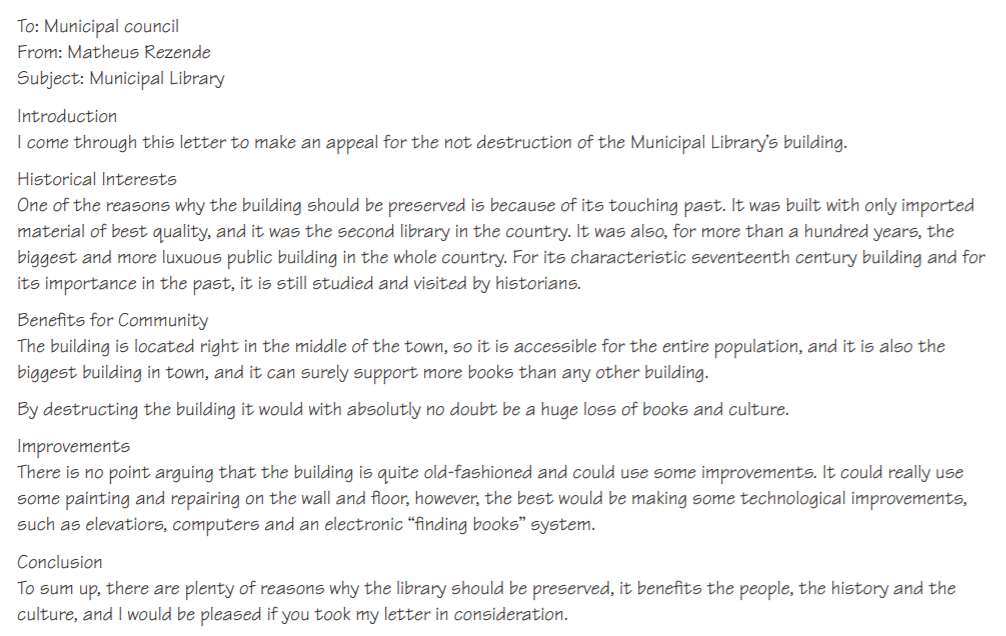
Examiner's Assessment Scale Template
Fill in an online version of the template below here or print off the hardcopy .
CAE Proposal Examiner Comments
Okay hopefully you've done that. Now we can compare the examiner's marks and comments with your own marks and comments. Also write down what you think are the most important points from the examiner's comments here . This will be really useful in helping you to realise what the examiners are looking for. If you can get into the mind of an examiner, you will get a higher mark in the exam.
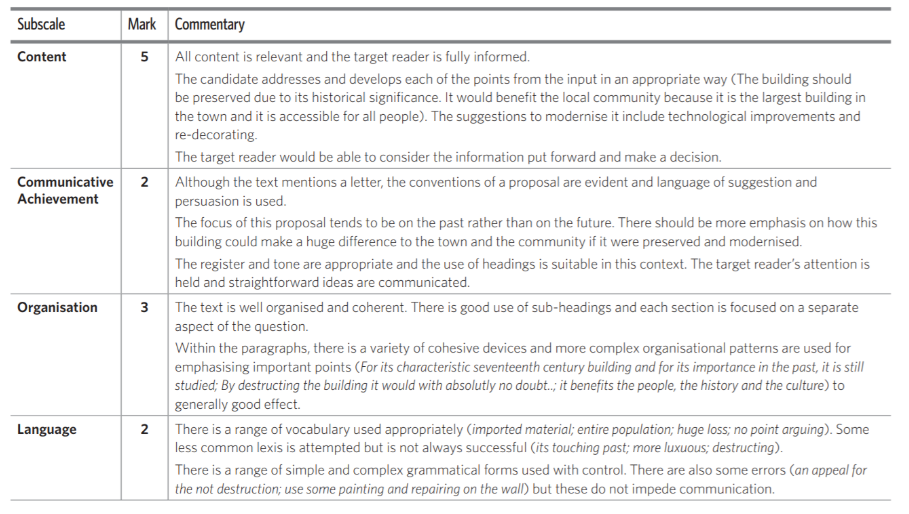
Examiner's Comments Critique
So hopefully you've done that now what we can do is we can have a look at the bits which I thought were really important points from these comments.

So even though the communicative achievement is not great it says the register and tone are appropriate and the use of headings is suitable in this context.
The language they've used is appropriate for their target reader and also target reader is fully informed because all of the content is relevant text has been well organized and coherent, easy to follow with a variety of cohesive devices and more complex organizational patterns used that's good. Also there has been a range of vocabulary used appropriately and finally a range of simple and complex grammatical forms so your sentences don't need to be lengthy they can be short and simple but if you can use some complex grammar and complex vocabulary with a good range of linking words or cohesive devices and the overall passage addresses the target reader and is written in an appropriate way for the target reader and it's well-organized, you're going to get good marks in the exam.
CAE Proposal Mistakes
When I read the proposal answer, I noticed some mistakes with the language. These could be to do with grammar or spelling or that it's difficult to understand, so I've written down some of these mistakes and what I'd like you to do is to try to find the mistakes below and correct them.
the not destruction of the Municipal
imported material of best quality
the biggest and more luxuous public building
By destructing the building
with absolutly no doubt
some painting and repairing on the wall and floor
the best would be
took my letter in consideration
CAE Proposal Corrections
Okay so hopefully you've spotted some of the mistakes above. Now what we can do is we can have a look at the corrections:
Sorry, this section is available for members only. Register here >>

CAE Proposal Example 2
- Read the C1 Advanced Proposal question below and then read the answer.
- Write down any mistakes you see and then c omplete the examiner's assessment scale here . Remember to use the examiners marking criteria to help you.
The Managing Director at your company has requested you to provide some ways to improve the morale of your colleagues. He wants you to propose some suggestions for what and how to motivate staff to improve their physical and mental health.
Similar companies have suggested healthy diets, sleep and exercise routines, socialising and taking holidays.
Write your proposal using these or your own ideas and provide reasons to support your suggestions.
C1 Advanced Proposal 2 - Sample Answer
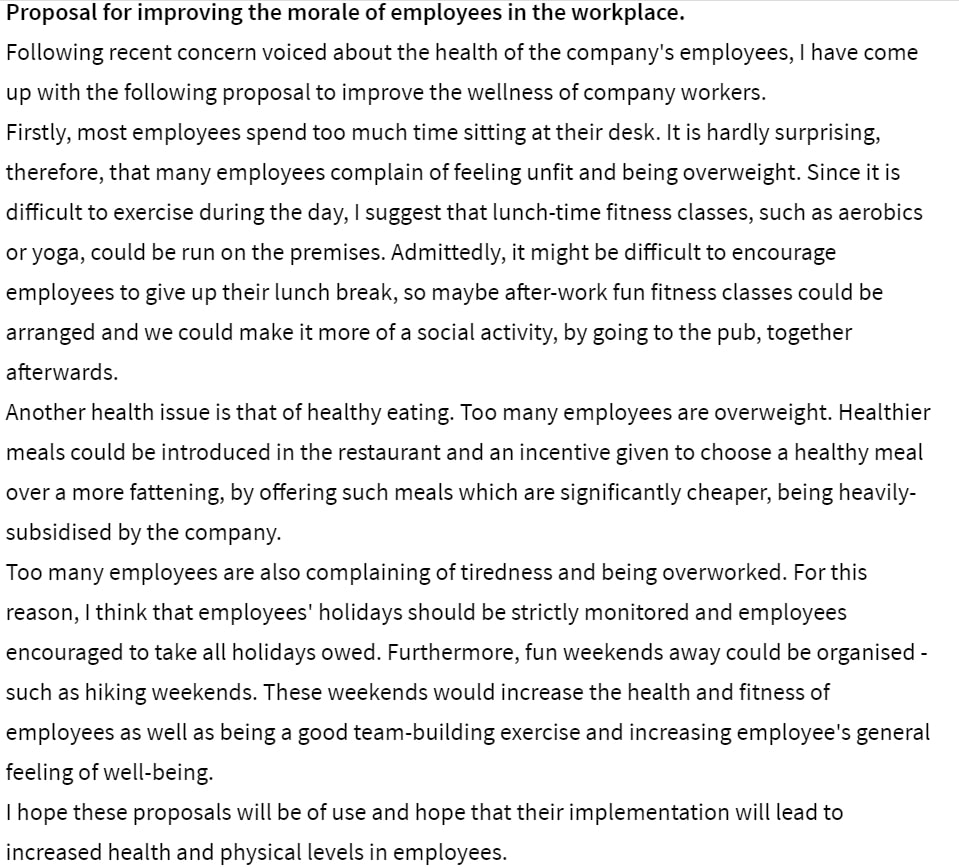
C1 Advanced Assessment Scale Template
Download here . Complete online here .
CAE Proposal 2 With Feedback
I will write my comments in bold and italics.
Proposal for improving the morale of employees in the workplace.
Following recent concern voiced about the health of the company's employees, I have come up with the following proposal to improve the wellness of company workers.
Firstly, most employees spend too much time sitting at their desk. It is hardly surprising, therefore, that many employees complain of feeling unfit and being overweight. Since it is difficult to exercise during the day, I suggest that lunch-time fitness classes, such as aerobics or yoga, could be run on the premises. Admittedly, it might be difficult to encourage employees to give up their lunch break, so maybe after-work fun fitness classes could be arranged and we could make it more of a social activity, by going to the pub, together afterwards. What would be the benefits of doing these things?
Another health issue is that of healthy eating. Too many employees are overweight. Healthier meals could be introduced in the restaurant and an incentive given to choose a healthy meal over a more fattening one , by offering such meals which are significantly cheaper, being heavily-subsidised by the company.
Too many employees are also complaining of tiredness and being overworked. For this reason, I think that employees' holidays should be strictly monitored and employees encouraged to take all holidays owed. Furthermore, fun weekends away could be organised such as hiking weekends. These weekends would increase the health and fitness of employees as well as being a good team-building exercise and increasing the employees general feeling of well-being among staff ( I tried to use different words to avoid saying ‘employees’ too many times) .
I hope these proposals will be of use and I hope that their implementation will lead to increased health and mental and physical health levels in employees.
C1 Advanced Sample Proposal Critique
Cae proposal example 2 - pass or fail.
Content - 4
Communicative Achievement - 4
Organisation - 3
Language - 4
Total: 15/24
In my opinion, this proposal is good enough to pass part 2 of the Writing paper. Good job!
CAE Proposal Example 3
You can find the following question in ' Cambridge English Advanced Practice Tests - Plus 2 ' by Nick Kenny and Jacky Newbrook.
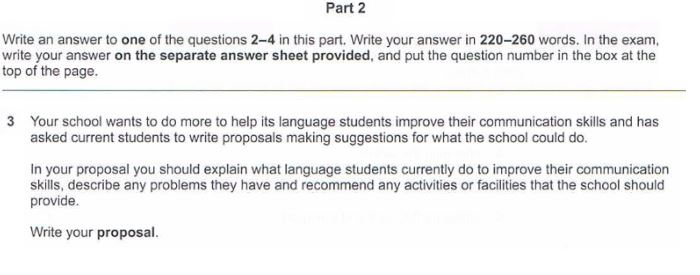
Print & Make Corrections On This C1 Advanced Proposal Answer
Download here .
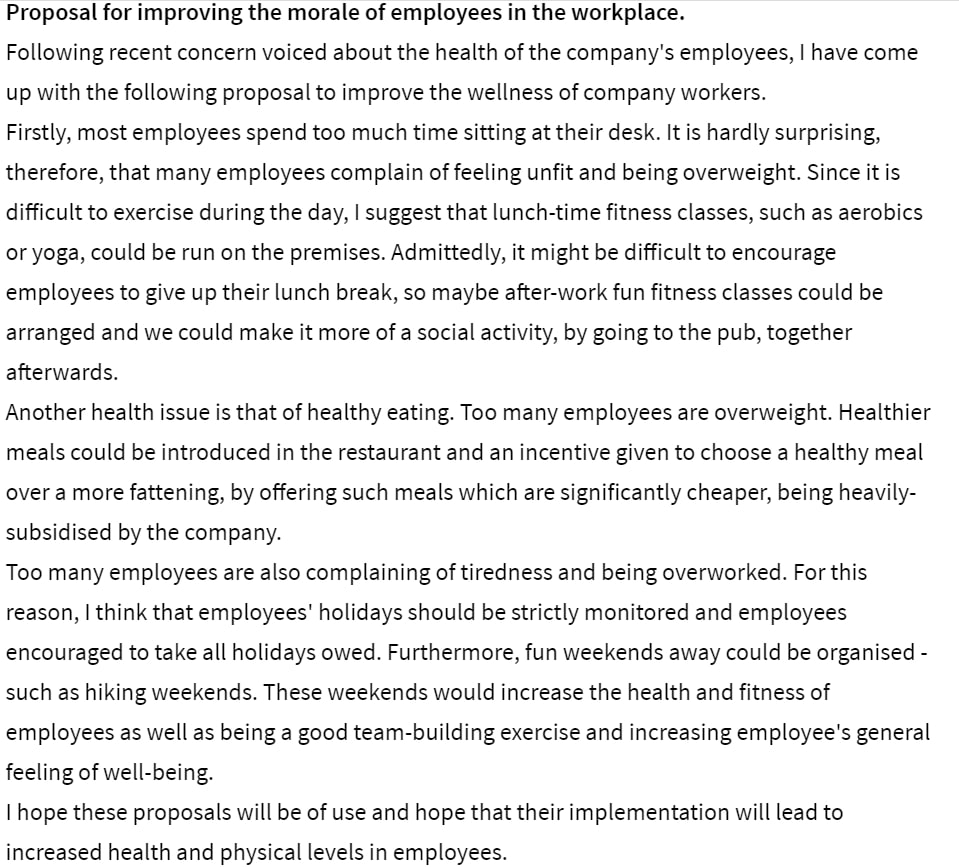
Complete This Assessment Scale Template
Download here >>
Online version >>
Check my corrections on the answer below...
Sorry, you are not current able to access this section. Register/upgrade here >>

How To Write A C1 Advanced Proposal - Feedback
Sorry, the content below is for higher level members only. Register/upgrade today >>

Pass or Fail
Sorry, this section is available for higher-level members only. Register/upgrade to access now >>
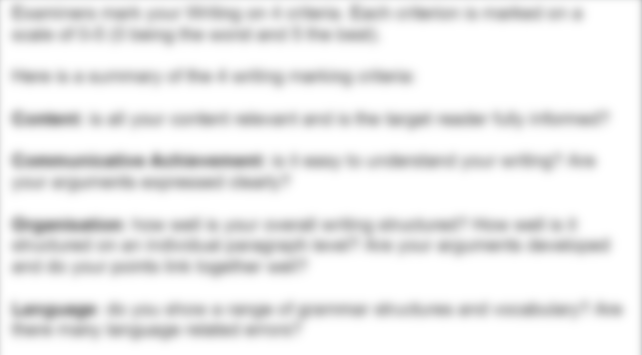
If you want to become a higher-level member of this site and access loads more CAE exam information... Register/Upgrade Here >>
Common c1 proposal questions.
So let's have a think about some common questions students have about proposals. Again, I advise taking and summarising the most important points below and adding them to this document .
Should the language be formal or informal?
Well this depends on who the target reader is if it's your colleague or one of your peers maybe it can be slightly more informal but most of the time it will need to be formal and it will need to be to someone who's your boss for example, so it does depend on the target reader but more often you'll need to be formal. If it's to your colleague it shouldn't be really informal, you should still write as if you're in a business mentality so you should still write in a formal way.
Should you use paragraphs and headings?
Paragraphs are good to use for every writing that you do and introductions and conclusions are also always important. Headings can be used for different points of the proposal so if you have a main point that you want to address, you can put a heading or a little title for this, but not necessarily in every proposal you write.
Class Activity
If you want to set your students a class activity without using computers. set them the following instructions:
- Read this proposal question, then take 5 minutes to write a plan for it here .
- Download and correct any mistakes you find on this proposal answer.
- Compare the last step with the mistakes I found here .
- Print and complete this assessment scale with your thoughts on the proposal.
- Is your assessment similar to this examiner's ?
- Print off this form and complete it with the tips and techniques you learn on this page and elsewhere.
I advise join my website to get ALL my extra resources.
You can find the instructions above using online templates etc. here .
1. Complete the exercise in the video below:
2. Write your own answer to the question above. You can also find other writing questions for C1 Advanced proposals in my book . You can submit a writing via my Cambridge writing exam service , then I will mark it and give you feedback based on the official marking criteria (if I have time).
3. Finally for homework you should read the Cambridge English Advanced handbook for teachers if you haven't already read this document it's a really useful document for every part of the C1 Advanced CAE exam so I really recommend it.
More CAE Proposal Writings >>
If you click the photo below , you can read my e-book! It contains 3 proposals along with 18 other CAE writings, all with my critique, comments and marks:

Next Page >>
2 thoughts on “ cae proposal c1 advanced | 1 great strategy ”.
This was very helpful! You’re a great teacher!!!
Thank you very much.
Leave a Reply Cancel reply
Your email address will not be published. Required fields are marked *
This site uses Akismet to reduce spam. Learn how your comment data is processed .
Which exam do you want to pass?
B2 first: fce >>, c1 advanced: cae >>, linguaskill >>.
You need Gold membership to access this…
Join now >>
Can you beat the quickest time and register within 24 seconds?
Let’s try >>
Can you beat the quickest time and register within 52 seconds?
Gold Membership
Can you beat the quickest time and register within 51 seconds?
Let’s do it >>
Marketing Permissions: Please select all the ways you would like to hear from Student Languages. By checking the box below you also agree to our Terms and Privacy policy .
You can unsubscribe at any time by clicking the link in the footer of our emails. For information about our privacy practices, please visit our website .
We use Mailchimp as our marketing platform. By clicking below to subscribe, you acknowledge that your information will be transferred to Mailchimp for processing. Learn more about Mailchimp’s privacy practices here.
Which exam do you want a discount for?
Which membership level do you want, free >>, pay monthly (£14.53) >>, pay annually (£84.47) >>.
Marketing Permissions
How would you like to receive your feedback and other useful English information? Please remember to check your junk/spam email! By checking the box below you also agree to our Terms and Privacy policy .
We use Mailchimp as our marketing platform. By clicking above to subscribe, you acknowledge that your information will be transferred to Mailchimp for processing. Learn more about Mailchimp’s privacy practices here.
Which exam do you want an e-book for?
* indicates required.
Marketing Permissions: How would you like to receive your free e-book and other useful English information? Please remember to check your junk/spam email! By checking the box below you also agree to our Terms and Privacy policy .
Privacy Overview
Main navigation
C1 advanced exam format.
C1 Advanced is a thorough test of all areas of language ability.
The exam is made up of four papers developed to test your English language skills. You can see exactly what’s in each paper below.
The formats below are the same for both the paper-based and computer-based exams and digital exams. Please note, during March 2024 we will be moving from our current computer-based exam delivery to Cambridge English Qualifications Digital, which will offer you even more benefits. Information on the switch and what this means for you can be found on our Cambridge English Qualifications Digital page.
- openbook Reading and Use of English
- compose Writing
- playlist Listening
- megaphone Speaking
openbook What’s in the Reading and Use of English paper?
The C1 Advanced Reading and Use of English paper is in eight parts and has a mix of text types and questions.
Part 1 (Multiple-choice cloze)
Part 2 (Open cloze)
Part 3 (Word formation)
Part 4 (Key word transformations)
Part 5 (Multiple choice)
Part 6 (Cross-text multiple matching)
Part 7 (Gapped text)
Part 8 (Multiple matching)
compose What’s in the Writing paper?
In the two parts of the C1 Advanced Writing paper, you have to show that you can write different types of text in English.
Part 1 (Compulsory question)
Part 2 (Situationally based writing task)
playlist What’s in the Listening paper?
The C1 Advanced Listening paper has four parts. For each part you have to listen to a recorded text or texts and answer some questions. You hear each recording twice.
Part 1 (Multiple choice)
Part 2 (Sentence completion)
Part 3 (Multiple choice)
Part 4 (Multiple matching)
megaphone What’s in the Speaking paper?
The C1 Advanced Speaking test has four parts and you take it together with another candidate.
There are two examiners. One of the examiners conducts the test (asks you questions, gives you the paper with things to talk about, and so on). The other examiner listens to what you say and takes notes.
Part 1 (Interview)
Part 2 (Long turn)
Part 3 (Collaborative task)
Part 4 (Discussion)
404 Not found
- B1 Preliminary (PET)
- B2 First (FCE)
C1 Advanced (CAE)
- C2 Proficient (CPE)
Not a member yet?
Choose exam paper...
Choose one of the exam papers below, to start.

- Privacy Policy
- New account
Login into your account...
Not a memeber yet? Create an account.
Lost your password? Please enter your email address. You will receive mail with link to set new password.
Back to login
Writing C1 Advanced (CAE): Guía Completa con Ejemplos
Luis @ kse academy.
- julio 10, 2019
El Writing C1 Advanced (CAE) es el primer examen de Writing considerado como nivel avanzado, y se encuentra en el examen C1 Advanced de Cambridge, también conocido por su nombre antiguo CAE (Certificate in Advanced English).
Al igual que en otros exámenes (B2 First y C2 Proficiency), el Writing del C1 Advanced es solo una parte de las 5 que componen el C1 Advanced. Y como ya he dicho anteriormente, basándome en mi experiencia como profesor de inglés, el C1 Writing es una parte difícil, pero de las más fáciles de mejorar a base de estudiar.
Por este motivo, en este artículo te voy a explicar exactamente cómo es el Writing del C1 Advanced (CAE) y te voy a mostrar un ejemplo de cada Writing del CAE . ¡Allá vamos!
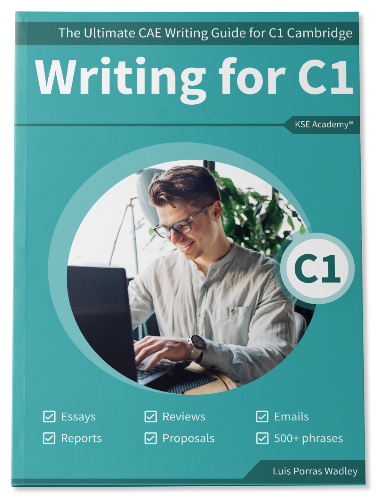
¡Nueva guía de Writing C1!
- 3 Ejemplos de cada tipo de Writing
- Essay, Review, Formal and Informal Email and Letter, Report y Proposal
- 500+ expresiones útiles listas para utilizar
- 95 páginas de contenido exclusivo
- Descripción completa del examen de Writing del CAE
- Descripción detallada de cada parte
- Criterios de corrección y preguntas frecuentes (FAQ)
Ver muestra o Comprar en Amazon
Writing C1 Advanced: Formal Email or Letter
Ejemplo de writing c1 formal email, writing c1: qué es el nivel c1.
Tal y como empezó a hacer Cambridge en el año 2015, el nombre del examen C1 Advanced especifica claramente el nivel del que se trata, es decir, un nivel C1 según el Marco Común Europeo de Referencia para las Lenguas (CMCERL) . El nivel C1 es la primera franja de competencia lingüística que define un nivel avanzado. Tal y como especifica el MCE, una persona con un nivel C1 en competencia escrita:
Puede producir textos claros, bien estructurados y detallados sobre temas de cierta complejidad, mostrando un uso correcto de los mecanismos de organización, articulación y cohesión del texto. Marco Común Europeo, p. 26
A nivel general ya apreciamos un cambio con respecto a niveles inferiores, y es el uso de las palabras «temas de cierta complejidad», ya que en nivel B2 se especificaba únicamente «temas diversos» y «temas generales».
Si analizamos más la sección de expresión escrita del MCE , un candidato que tiene un nivel C1 escrito:
- Escribe textos claros y bien estructurados sobre temas complejos resaltando las ideas principales, ampliando con cierta extensión y defendiendo sus puntos de vista con ideas complementarias, motivos y ejemplos adecuados, y terminando con una conclusión apropiada.
- Escribe descripciones y textos imaginarios de forma clara, detallada y bien estructurada, con un estilo convincente, personal y natural, apropiado para los lectores a los que van dirigidos.
- Escribe exposiciones claras y bien estructuradas sobre temas complejos resaltando las ideas principales.
- Amplía con cierta extensión y defiende puntos de vista con ideas complementarias, motivos y ejemplos adecuados.
Como puedes apreciar, un Writing de nivel C1 ya se trata de un nivel complejo, con unas expectativas del lector que también apuntan bastante alto.
Y ahora que conocemos cómo de avanzado es el nivel del Writing C1, vamos a ver cómo es el Writing del CAE , viendo ejemplos de ejercicios de Writing del C1 y de las instrucciones.
Cómo es el Writing C1 Advanced
El Writing del CAE sigue la línea de otros exámenes de Cambridge desde 2015, por eso, los candidatos tienen que escribir dos textos de 220 – 260 palabras en 1 hora y 30 minutos . Estos dos textos son de tipos diferentes, como veremos en la siguiente sección, y el objetivo es que demuestres una serie de mecanismos lingüísticos escritos de un Writing de nivel C1 .
Ahora pasaremos a ver los diferentes tipos de Writing del C1 Advanced (CAE) y ejemplos de cada una de ella.
Tipos de Writing C1
Estos son los diferentes tipos de tarea que puedes encontrarte en el CAE Writing actual:
- Email (informal or formal) or letter (informal or formal)
Estos tipos de Writing ya se vienen dando desde el B2 First, excepto el proposal , que es un tipo de tarea nueva de Writing que se introduce en el CAE (nivel C1), y que sustituye al article , que desaparece a este nivel.
Writing C1 Advanced: Part 1 – Essay
Al igual que en otros exámenes de main suite de Cambridge, la primera parte de este examen de Writing consiste en escribir un essay , es decir, un ensayo. A diferencia de la segunda parte, en esta únicamente tienes una opción, por lo que tienes que escribir un essay obligatoriamente.
Como ya sabrás, un ensayo ( essay ) es un tipo de Writing de C1 muy común a nivel académico, siendo este uno de los objetivos principales de este examen de inglés. Obviamente, en este caso no podemos escribir demasiadas palabras (alrededor de 260 como máximo), sino que se trata de demostrar que eres capaz de desenvolverte cómodamente al escribir sobre temas de ámbito académico. Además, para facilitar las cosas, esta tarea siempre presenta las instrucciones de la misma forma y con el mismo número de puntos.
A continuación tienes una captura para que veas cómo son las instrucciones de un essay en el CAE :
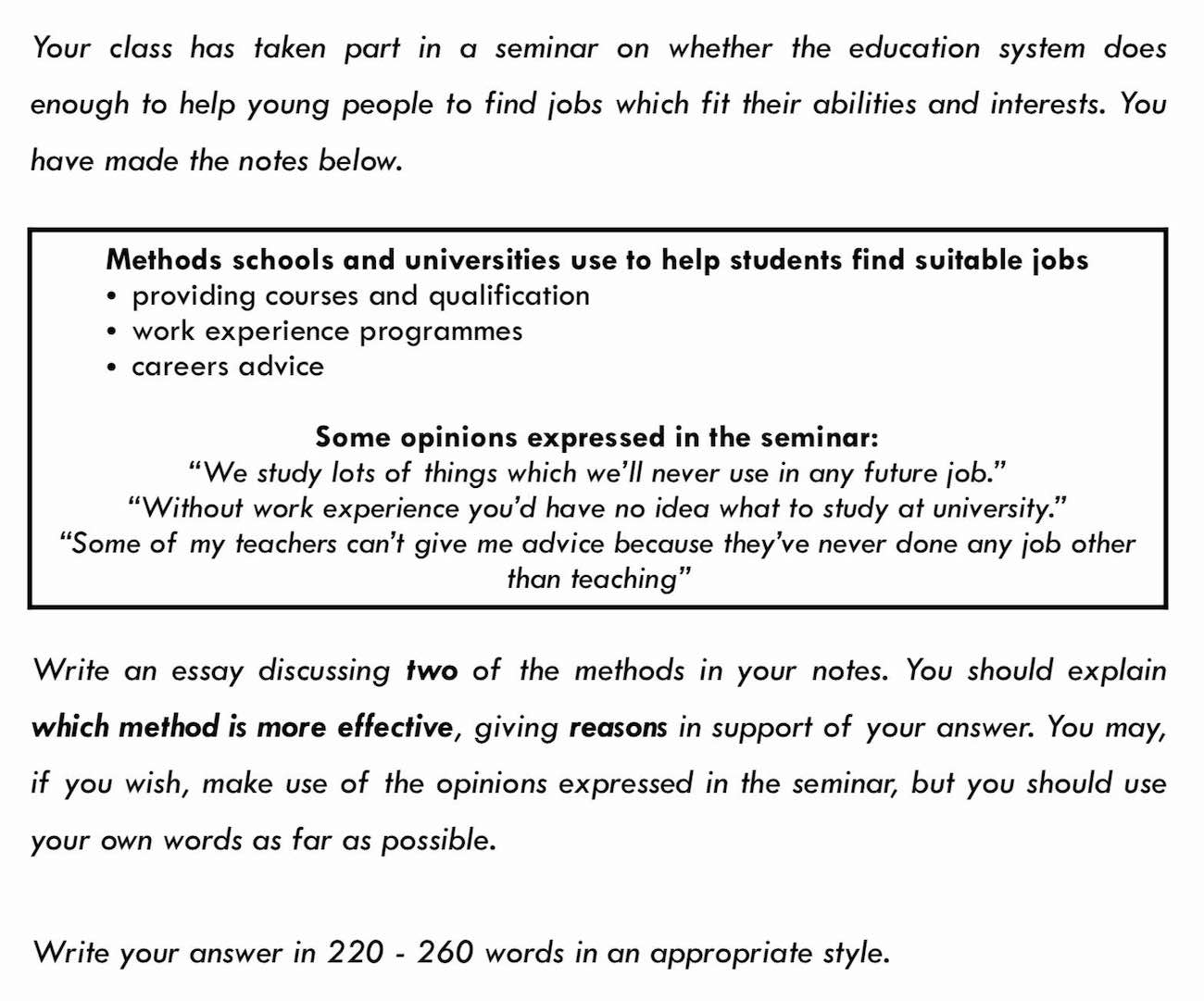
Como puedes leer en la imagen superior, la idea es que ha habido un seminario en el que tu clase ha participado y cuya temática es la efectividad del sistema educativo para ayudar a los jóvenes a encontrar trabajo. Se trata de un tema complejo y de nivel académico . A continuación tienes una serie de anotaciones : primero tienes los puntos que ha tratado el seminario y después una serie de citas sobre opiniones expresadas durante el seminario. Si te fijas bien, cada opinión corresponde a uno de los puntos tratados.
A continuación, debes escribir un essay de nivel C1 hablando sobre 2 de esos puntos y decidiendo cuál es el más apropiado. Y todo ello en 220 – 260 palabras. Haz click aquí para ver exactamente cómo escribir un Essay para el C1 Advanced (CAE) .
Pasemos ahora a la segunda parte.
Writing C1 Advanced: Part 2
En esta parte debes escribir otro writing de 220 – 260 palabras, pero a diferencia de la parte 1, en esta sí que puede elegir entre 3 tareas diferentes. Pero no te confundas, porque aunque únicamente haya 3 tareas, pueden aparecer hasta 7 tipos de Writing de C1 , como hemos viso antes: review , formal letter/email , informal letter/email , report o proposal .
Veamos un ejemplo de cada tipo de Writing del C1 Advanced , esto es, del enunciado.
Writing C1 Advanced: Review
Uno de los tipos de tarea de Writing que pueden aparecer en el C1 Advanced es la review o reseña. Esta tarea suele ser bastante complicada, desde mi punto de vista, ya que se trata de un tipo de Writing muy concreto. Y el problema es que pueden pedirte que escribas una review sobre una película, un libro, una serie, un objeto, una página web, un programa de televisión, etc. En este caso vamos a ver un ejemplo de instrucciones de una review de una película .

Writing C1 Advanced: Report
El report es uno de los Writing de C1 más sencillos, en mi opinión. ¿Por qué? Porque desde mi punto de vista es de los que menos creatividad necesitan y, por lo general, esto lo suele hacer más fácil y nos da más lugar a centrarnos en nuestro inglés escrito.
Un report no es más que un informe, es decir, un escrito en el que analizamos algo que ya ha ocurrido o que ya existe. Por ejemplo, pueden pedirte que escribas un report sobre una visita, un programa de intercambio, una empresa, la situación de algo en tu país, etc.
Haz clic aquí para saber cómo escribir un C1 report .
En el caso que tenemos a continuación se trata de escribir un report sobre la influencia que tienen los programas de televisión en inglés sobre tu país. Lee la tarea con detenimiento:
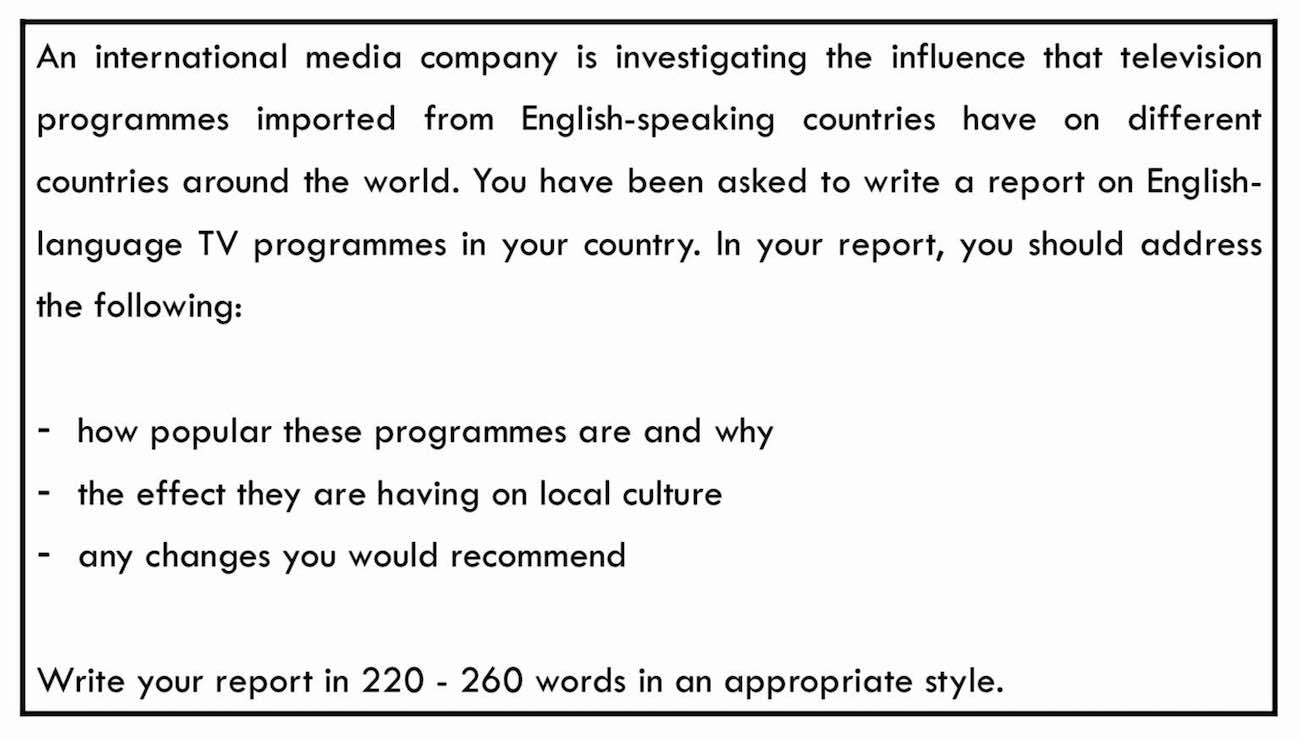
Como ves, se trata de una tarea de Writing que requiere un tono muy formal, ya que va dirigido a una compañía internacional y se trata de un análisis a fondo de la situación. Más tarde veremos un ejemplo de respuesta de report .
Writing C1 Advanced: Proposal
Ahora vamos a ver las instrucciones de un proposal para C1 Advanced, un tipo de Writing nuevo que se introduce específicamente en este nivel. El propósito de este tipo de Writing es hacer una propuesta para algún tema sobre el que nos preguntan. Un tema muy típico es ser estudiante o trabajador de una facultad que ha recibido una especie de beca económica, por lo que te piden que hagas una propuesta sobre cómo invertir dicho dinero.
Aunque nada tiene que ver ese tema con el que vamos a ver en las siguientes instrucciones de proposal :
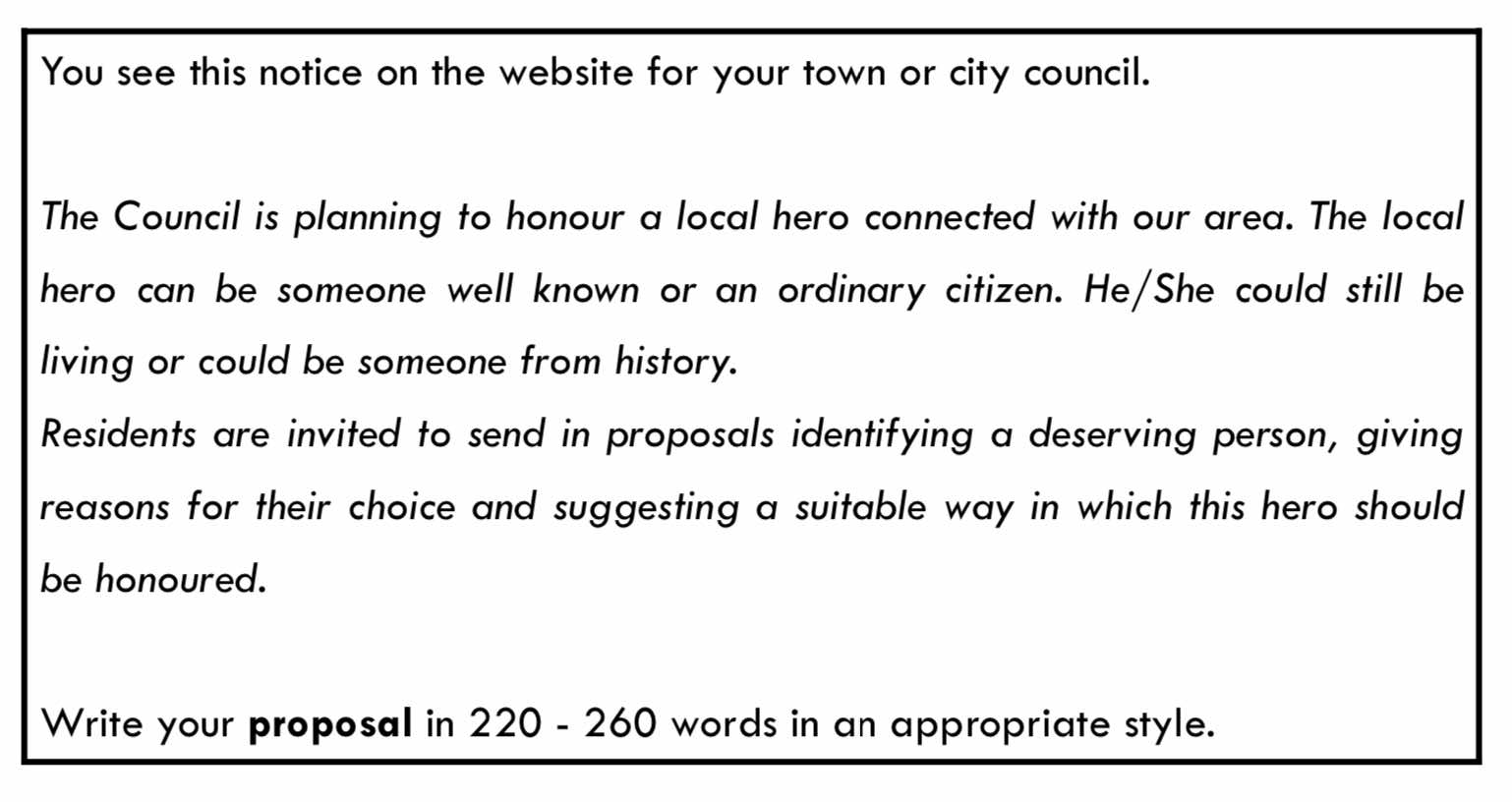
El formato del texto, como veremos más adelante, es muy parecido al del report , pero mientras que un report se centra en algo ya pasado (para hacer propuestas de mejora), un proposal se centra en algo para el futuro.
Writing C1 Advanced: Informal Email or Letter
Un email y una carta, en cuanto a su formato, son lo mismo. Por eso los voy a tratar a ambos por igual en este apartado. Y, en este caso, voy a enseñarte un ejemplo de email informal para C1 Advanced , aunque también podría tratarse de un formal email or letter .
Aquí te dejo un típico ejemplo de tarea de email Writing C1 en la que te piden que le escribas a un amigo.

Y a continuación tienes un ejemplo de tarea para escribir un email formal para el C1 . Como puedes ver, se trata de una carta escrita al autor de un artículo de periódico, conque el tono debe ser formal, al igual que el vocabulario y la gramática utilizada.

Ya que hemos visto ejemplos de cada tipo de tarea, pasemos ahora a ver un ejemplo de cada tipo de writing C1 , es decir, de respuestas apropiadas para las tareas de writing.
Ejemplos de Writing C1 Advanced (CAE)
En esta sección vamos a ver un ejemplo de Writing C1 para cada tipo de tarea. El propósito de esto que te familiarices con cada tipo de Writing y que te hagas una idea de lo que se espera de ti en el examen. Además, he intentado simular un nivel C1, ni muy fuerte ni muy flojo, para que sepas a lo que deben parecerse tus tareas de Writing, como mínimo. Empecemos.
Ejemplo de Writing C1 Essay
Un essay, como hemos visto antes, es un Writing formal en el que debes hablar de 2 ideas (de 3 que aparecen en las instrucciones) y entre las que debes elegir una de ellas como la mejor opción , siempre justificando tus opiniones. Para expresar tus ideas, debes demostrar un nivel C1 a través del vocabulario, las estructuras gramaticales, lenguaje apropiado al contexto, fórmulas, etc.
A continuación tienes una respuesta a la tarea planteada anteriormente:
Helping students find suitable jobs Nowadays, there seems to be a serious problem with our education system. A growing number of youngsters are finding themselves stuck in jobs that have little or nothing to do with their degrees. As a consequence, frustration and unemployment are on the rise, as young workers eventually tend to resign. But is there something to be done about this? Experts believe so. On the one hand, it is believed that when choosing a degree, students are not mature enough. Therefore, they lack the necessary experience to know what they really desire for their future. If they were to have more experience, they would choose more wisely. In turn, there would be fewer college dropouts and more fulfilled young workers. For this reason, experts claim that embarking on a work experience programme would be truly beneficial. On the other hand, recent research points out that students lack appropriate careers guidance. Not only are teachers not qualified for this task, but also they lack the resources to provide students with guidance. Thus it is of utmost importance to hire professional careers counsellors, who can help students develop more accurate expectations of their careers and professional opportunities. In conclusion, I hold the view that if we were to tackle these two issues, our education system would become more effective in aiding students to become satisfied workers after finishing their university studies. However, implementing work experience programmes would bring about greater benefits for youngsters than seeking profesional counselling. This is so because I believe that our own experience is more valuable than someone else’s professional opinion.
Este ejemplo, que he escrito yo mismo, es un buen ejemplo de essay para el C1 Advanced (CAE). En este caso, trato 2 de los puntos que me han dado (párrafos 2 y 3) y hago una buena introducción (párrafo 1) y una buena conclusión (párrafo 4). Fíjate además cómo van separados los párrafos y el tipo de conectores, vocabulario y gramática que uso.
Ejemplo de Writing C1 Review
El siguiente ejemplo es de una review de una película que escribí para mis alumnos de C1. Como puedes ver, se trata de una película real ( Room ) y en ella hablo de varias cosas esenciales en cualquier review de película, libro o serie: argumento , personajes/actores , recomendación , temática , por qué me gusta , etc.
Room There are films which represent a turning point in the life of every film buff, whether it be for the plot, the actors or the themes. In my case, this came about when I watched Room, a heartbreaking yet inspiring production directed by Lenny Abrahamson. Set in present-day Canada, the plot of this human drama revolves around the story of a young woman, Ma, who was kidnapped 7 years ago and has been locked up ever since in a minute back-garden shed – referred to as “room” throughout the whole film. After regular forced, sexual encounters with her kidnapper, Ma has given birth to Jack, who is now 6 years old. During this time, room is the only world he knows, thus being completely unaware of what lies beyond those four walls. However, Ma will do everything in her power to break free and put an end to their ordeal. The characters are wonderfully played by all the actors, who put in an exceptional performance, especially the young, child actor who plays Jack. He really provides the part with a lot of personality and wins the viewers’ sympathy from the outset. What made me fall in love with this film was that it deals in an extremely realistic way with major themes like violence, motherly love and depression. However, the icing on the cake is how this picture gives us hope to overcome severe difficulties. If you’re keen movie lover and enjoy thought-provoking stories, I wouldn’t hesitate to log on to Netflix and watch it straightaway. You will always remember it as one of the best films you ever saw.
Si te has fijado bien, verás que este tipo de Writings es muy demanding (exigente) en cuanto a vocabulario se refiere, ya que son muy descriptivos y hay que hacer mucho uso de adjetivos potentes ( heartbreaking, thought-provoking, exceptional, etc.). Además, el vocabulario ha de ser muy específico, especialmente tratándose de un nivel C1.
Ejemplo de Writing C1 Report
En esta sección tienes un ejemplo de report para el CAE. Al igual que antes, se trata de la respuesta a la tarea de Writing presentada en la sección anterior sobre el impacto de la televisión de habla inglesa sobre mi país.
Como habrás apreciado inmediatamente a simple vista, la estructura de un report es muy especial . Y es que, aparte del título, cada párrafo o idea es en realidad un subapartado introducido por un subtítulo. Además, el registro debe ser bastante formal, como podrás leer a continuación:
English-language TV Programmes in Spain Introduction The aim of this report is to analyse the introduction of English-language TV programmes to Spanish television. In doing so, this document will focus on the popularity of such programmes, the effect they have on local culture and how they could be improved by making some minor changes. Popularity According to the latest research, English-language TV programmes have increased in popularity in Spain during the last decade as a result of new television features like TV on demand. The main issue seems to be that most viewers are watching a dubbed version of these shows. However, as English language fluency increases within the country, more and more viewers tend to choose the original version of these shows with the intention of boosting their fluency even more. Effects on local culture While the impact on Spanish culture is not as great as on other cultures, due to relatively scarce differences between American or English societies, some changes have been registered. Firstly, national TV productions are struggling to compete with American programmes, which have a more generous budget. Secondly, according to sociologists, language learners are benefiting not only from language input, but also from a broader cultural awareness. Recommendations In order for English-language shows to have a more positive impact on our society, I would recommend not dubbing them. Consequently, viewers would be somewhat obliged to watch these programmes in English, hence improving their English language skills. Furthermore, as a teacher, I would suggest Spanish TV channels provide viewers with online educational resources and support so that they would be able to make the most of watching shows in the original version.
Ejemplo de Writing C1 Proposal
La estructura de un proposal , como puedes observar, es (o puede ser) exactamente igual que la de un report . No es obligatorio que sea así, pero sí recomendable.
En el ejercicio de proposal de Writing de C1 que vimos anteriormente, me pedían que propusiera a una persona para homenajear en mi ciudad, que es Granada. Así que aquí tienes el ejemplo de proposal con mi nominación a un supuesto José Pérez :
Granada’s Most Committed Teacher Introduction The aim of this proposal is to suggest honouring a local figure who I believe is worthy of the city’s respect and admiration. The person I have chosen is José Pérez, a renowned educator, who sadly passed away last year, at the age of 73. Achievements Born and raised in Granada, Mr Pérez is famous in this city for his work as educator. In his early years, he started working in a secondary school in an extremely run-down area, thus dealing with extremely troublesome students and families. However, instead of giving in to difficulties, he managed to increase dramatically the number of high school graduates. Furthermore, seeing how uneducated families in this area were, he set out to found a local charity which teaches youngsters and adults alike. These are the main reasons why I believe Mr Pérez should be honoured by the local council. Tribute The best way in which Mr Pérez should be honoured is by renaming the school where he used to work after him. I believe he would have been deeply grateful for this. However, I would also like to propose paying him homage by holding a local holiday on 10th March, coinciding with his birthday. On this day, schools would be expected organise especial events in his memory. Conclusion On the whole, I believe that I am not alone when I say that Mr Pérez’s work has had an impact on the city which no other person has achieved in the last 100 years. For this reason, I truly hope you consider this proposal, as it would make many people happy.
Ejemplo de Writing C1 Informal Email
Aquí te dejo una carta o un email informal respondiendo a “mi amigo australiano” Mike. Lo esencial, como verás ahora, de cualquier email o carta, aparte de que esté bien escrito y en un registro adecuado, es la estructura. Fíjate cómo divido este email en:
- párrafo de apertura
- párrafos con ideas principales
- párrafo de cierre
En este caso, al tratarse de un ejemplo de email informal de C1 , el lenguaje es muuuuuuy informal. De hecho, lo he exagerado bastante to make a point y que se vea que domino el registro informal. Quizás te recomendaría que, si escribes un email informal, no te pases tanto como lo he hecho yo, jeje.
Hi Mike! How’s it going, bro? Things are just swell over here: the weather’s great and I’ll be off work soon for a couple of weeks. So it’s absolutely fantastic that you’re doing that course you told me about here in Granada. So here’s a few things to keep you busy in your spare time, which, BTW, you’ve got tons of, haven’t you? If the weather’s not that great when you’re here – though I doubt it! –, you might wanna make the most of the cafés and tea rooms in Granada. Tea rooms are a great part of social life here and you can find a bunch of them around Elvira Street. They all serve super tasty Muslim-style tea and some even have stand-up performances on weekends. Make sure you check’em out! However, the weather’s most definitely gonna be great at some point during your stay – remember, this is Andalusia! – so walking up and down the city is the best way to get to know the city. Besides, walking will help you get rid of those extra kilos you put on over Xmas, haha! So I recommend that you pick a few spots you’d like to visit, and check them out with your classmates after your lessons. IMO, you can’t miss the Alhambra, the greatest ancient Muslim palace in the world; or St Nicholas Viewpoint. They’re simply two of the best things you’ll come across in Granada. Seriously! Anyways, mate, I’d better get going. I’ve got tons of things to do before my holidays. Let me know if there’s anything else I can give you a hand with. Take care, bro! Luis
LOL. Me parto leyendo mi propio email.
A continuación te dejo un ejemplo de email formal para el CAE. Es la respuesta a la tarea planteada en el punto anterior, acerca del artículo de periódico con el cual no estoy de acuerdo. Fíjate en el registro utilizado y verás qué formal suena y cuánto más impone un tono formal que un tono informal.
Dear Sir, My name is Luis, I am a child psychologist and I am writing with regards to your latest article about the effect of new technologies on our children, which was recently published in our local newspaper. I am afraid that, although I understand why you may hold such views, I disagree with most of the points you put forward. To begin with, you categorically claim that children’s lives are worse now than they used to be in the past. However, not a single scientific paper published in the last 10 years regarding our infants’ well-being supports this claim, which clearly suggests that it is biased and unfounded. I am a child psychologist, currently conducting relevant research in this field, so I am well-informed and know what I am talking about. Furthermore, in your article you place all the blame on new technologies and the internet, as if these were directly responsible for children’s lack of a healthy lifestyle. No reference do you make, whatsoever, to parents’ responsibility in the matter, which, from my point of view, makes all the difference. The use our children make of the internet is entirely dependent upon how and for how long their parents allow them to use it. It can be a fantastic tool if used responsibly, or a terribly dangerous one if used carelessly. As an expert in the matter, I would be more than willing to contribute with my expertise to further articles dealing with children’s psychology and well-being, which you or the newspaper may wish to publish in the future. Yours faithfully, Luis
Writing C1 Advanced (CAE): cómo se evalúa
Cualquier tarea de Writing del CAE se evalúa en torno a 4 criterios de evaluación fundamentales, al igual que el B2. Estos son: Content , Communicative Achievement , Organisation y Language . Veamos ahora en qué consiste cada uno para que te hagas una idea de cómo leer tu Writing una vez finalizado:
- Content : Este criterio tiene como objeto evaluar cómo de bien has sabido completar la tarea y responder a todo lo que se pedía . En este sentido es importante que respondas a cada punto propuesto en el ejercicio (en este caso te piden 2) y que la información que escribas cubra bien cada punto y la tarea en general, de manera que el lector quede bien informado con respecto al objetivo del enunciado.
- Communicative Achievement : Este apartado de evaluación tiene como objeto determinar cómo de apropiado es tu Writing con respecto al ejercicio propuesto. En este sentido, es especialmente importante el estilo y el registro con el que hayas escrito. Es decir, si a tu amigo australiano Mike le escribes empezando con Dear Sir , perderás puntos. Al igual que si utilizas muchas contracciones en un application letter , cuyo registro se supone formal.
- Organisation : ¿Tu writing tiene una progresión lógica y está correctamente estructurado ? Perfecto. Entonces probablemente obtengas buena nota en este criterio. Por lo general, cualquier Writing de C1 debe estar separado en párrafos coherentemente interconectados , con oraciones coherentes y bien cohesionadas, ofreciendo una progresión lógica y fácil de seguir. Para ello, has de hacer uso de una serie de conectores avanzados y estructuras gramaticales cohesivas propias de un nivel C1, es decir, expresiones avanzadas que no suelen aparecer en niveles inferiores.
- Language : En esta sección, obviamente, debes intentar que tu gramática y vocabulario se encuentren en un nivel C1 (que no es fácil) y de no cometer errores lingüísticos. A este nivel tan avanzado, se supone que no debes cometer fallos. No vas a suspender si los cometes, pero dependiendo de cómo de chungo sea el error, podrás perder más o menos puntos.
Consejos para el Writing C1 Advanced (CAE)
Como cada parte del C1 Advanced, para el Writing del Advanced existen muchas estrategias importantes que te ayudarán a cumplir los requisitos que los correctores están buscando. Por lo general, yo siempre recomiendo hacer lo siguiente:
- Planea lo que vas a escribir antes de escribir . Jamás , repito, jamás comiences a escribir sin saber de lo que vas a hablar. Ni siquiera aunque lo hayas pensado. Hacer anotaciones sobre cómo vas a organizar tu Writing es fundamental para hacer que sea coherente y que al lector le resulte fácil de seguir. Además, evitarás pasarte con el número de palabras y que un párrafo sea mucho más largo que otro y tengas un Writing descompensado. Lo ideal es siempre hacer un esquema con las ideas principales, y comenzar a partir de ahí.
- El lector es más importante que tu abuela . A ver, tu abuela es muy importante, pero no creo que ella vaya a corregirte el examen. Así que piensa, ¿quién va a leer mi Writing? . Por ejemplo, si vas a escribir una review para una revista online, el tono que deberás utilizar será estándar o informal, pero si se trata una carta para solicitar un puesto de trabajo, tendrás que resultar más serio y formal. Por ello, siempre fíjate en quién será tu lector y adátate a él/ella/ellos/ellas.
- Escribe un borrador y no dejes de mejorarlo . Escribir todo genial de primeras es muy difícil. Eso solo está al alcande de unos pocos como yo (Ha! ha!). Por este motivo, tu proceso de escritura siempre debe incluir un primer borrador, que luego reescribirás doscientas mil veces ( Dar sera, pulir sera , como diría Miyagi). De este modo, mejorarás distintos aspectos de tu Writing como el vocabulario y la gramática, los conectores, etc. Además, evitarás fallos y errores absurdos y verás si es coherente o no, y un largo etcétera de cosas útiles. Esto es fundamental, te lo digo en serio.
- Define bien los párrafos de cada Writing . Sé que te puede parecer una tontería, pero definir los párrafos de un Writing hace que el texto, aparte de organizado, sea visualmente atractivo. Esto puede jugar a tu favor para causar una buena impresión en el lector (corrector).
- Escribe con conocimiento de causa . A ver, estás en un examen de inglés en el que tienes que demostrar lo que sabes. Es decir, cuando escribas intenta lucirte utilizando ciertas estructuras a propósito. Has estudiado las condicionales, ¿verdad? Pues mete una condicional. ¿Y los comparativos? También, pues mete una oración comparativa. ¿Te acuerdas de ese tema del medioambiente que viste con tu profe de inglés? Genial, pues mete palabras como greenhouse effect, acid rain, etc. ¡Intenta lucirte, copón, que pa eso estamos aquí! xD
- Revisa antes de darlo por terminado . Obviamente, nunca entregues un ejercicio de Writing sin revisar. Tienes que hacer de self-proofreader, buscando posibles erratas, errores ortográficos, faltas de concordancia, etc. Revisando evitarás errores muy tontos y comunes que podrían afectar muy negativamente a tu nota. Recuerda, dar sera, pulir sera .
Pues bien, después de este megapost ya debes tener una idea bastante más clara de cómo es el Writing del C1 Advanced. Pero eh!, si aún así te queda alguna duda, no dudes en dejarme un comentario y preguntarme lo que quieras, que para eso estoy aquí, mi joven padawan .
Que la fuerza te acompañe y don’t forget to keep smiling!
68 comentarios en “Writing C1 Advanced (CAE): Guía Completa con Ejemplos”
Fantastic material
Thanks for your feedback! 🙂
Gracias a ti, Merche. Un saludo!
Thank you very much for the material!
Thank you very much for your comment. Take care! 🙂
¡Buenísima guía! Estoy segura de que me servirá en mi preparación. ^-^ Por cierto, no sé si me lo he pasado mejor aprendiendo nuevas cositas acerca del inglés o deleitándome con la forma de redactar de Luis; ¡he flipado! Ah, y… first time in my life que veo un «xD» en una pedazo de entrada sobre el writing de C1, OMG xD. Me he sentido como en casa —o como en mi propia mente— mientras leía todo esto, tanto que ahora mismo debería seguir con mi writing de C1 en vez de dejar que me siga volando el tiempo mientras bicheo el resto del blog.
Gracias por haber invertido tu tiempo en esto, Luis, seguro que sigues ayudando a muchas personitas más <3. Un saludo, Ale
PD: ¡ojalá viviese en Granada! No me pensaría dos veces el ser alumna de KSE Academy :3. Keep Smiling ~~
Hola Alexandra! Muchísimas gracias por tu comentario. Probablemente el mejor que me han escrito en estos años. 😀 Es una pena que haya tardado más de un mes en responder, pero últimamente estoy un poco desconectado de la web; entre unas cosas y otras, no tengo mucho tiempo, jeje. Take care & keep smiling!
Gracias Luis por este espectacular post. Me examino de C1 en junio de este año y me ha venido muy bien coger ideas de tus escritos. Gracias por dedicar tu tiempo en poner un poco más fácil esta ardua tarea. Take care Inma
Hola Inma. Muchas gracias por tu comentario. Me alegro de haber podido ayudarte un poco, jeje. Que tengas mucha suerte en tu examen!
Pedazo de recomendaciones, Luis. Llevo leído mucho sobre writing de C1 y sin lugar a dudas el mejor con mucha diferencia, con humor, ejemplos y recomendaciones realmente útiles. Gracias por compartirlo con todos. Keep going!
Wow, gracias por tu super guía.
Util, amena y divertida, me parto yo tambien con el mail informal, y ya me he agenciado un par de tesoritos jejeje.. De la misma manera, es verdad lo fulminantemente seria y contundente que suena la respuesta formal al mail!!
Yo aterricé por aquí buscando consejo acerca de las review ya que o me quedo corta o terminan siendo auténticas filípicas.. y que gusto la del ejemplo corta y concisa. A ello que me pongo!
Pero lo mejor de todo, es que invitas a seguirte, seguro que debe ser un gusto tenerte como teacher. BTW. soy un B2 que he decidido seguir adelante así que no te extrañe encontrarte con algún writing para chequear en el próximo curso. Thanks Y
Hola Mariona. Muchísimas gracias por tu comentario, significa mucho para mí. Me alegro de que el contenido de la web te sea útil. Espero verte por aquí más a menudo! Un saludo!
Muchísimas gracias por la guía. Es fantástica y seguro que me sirve de mucha ayuda en mi preparación.
Muchas gracias por tu comentario, Inés. Que tengas mucha suerte en tu preparación. 🙂
Genial, or fin un contenido de los diferentes estilos explicados de forma clara y amena, gracias por hacer algo tedioso de forma didáctica y amena.
Muchas gracias por tu comentario, Pedro. Me alegro de que te haya sido útil. Un saludo!
Magnífico para repasar!! Mañana tengo mi examen del C1 y me ha servido mucho!! GRACIASSS
Hola Elena. Espero que te haya salido el examen muy bien. Muchas gracias por tu comentario!
Hola! Muchas gracias por la guía, me ha servido mucho. Me examino el 11 de Julio de C1 Tenía una duda: en el essay o en el report ¿hay que dar tu opinión? es que para el B2 me dijeron que solo en el último párrafo y cosas así, y no sé si es igual en este. Y una cosita más: un essay y un report a la hora de escribirlo ¿pueden tener formas parecidas?, es decir, ¿puedo poner «secondly», «another point to consider», «as a conclusion» en ambos? ¿Tienen mucha diferencia entre ellos?. Y mi profesora me dijo que si te pasabas de las 260 palabras (si eran 30 más o así) no pasaba nada, ¿me lo confirmas?
Hola Ana. Muchas gracias por tu comentario. 🙂 Realmente, la forma de hacer los Essays y Reports en B2 o C1 no cambia. En un Essay siempre tienes que dar tu opinión. Yo siempre recomiendo 2 opciones: 1) Dar tu opinión al principio (primer párrafo) y utilizar los siguientes párrafos para justificarla, con conclusión en el último; o 2) Plantear la «incógnita» en el primer párrafo, valorar las consideraciones en los siguientes párrafos y finalmente dar tu opinión. Realmente, mientras esté bien escrito, con sentido, no hay problema. Pero SIEMPRE tienes que dar tu opinión en un Essay porque es lo que te preguntan. 🙂
En cuanto al Report, obviamente, como ves en este post, la estructura es muy diferente. Los conectores pueden ser los mismos, si es lo que te preocupa, pero la estructura de un Report es recomendable que tenga un título y un subtítulo por cada párrafo/apartado. Y tu opinión, no sé si siempre tendrás que darla, porque básicamente depende de lo que te pidan, pero por lo general te indican que des recomendaciones o hagas alguna propuesta de mejora, entonces… en cierto modo, eso es dar tu opinión, jeje.
Con respecto al número de palabras, tu profesora tiene razón. El número de palabras es orientativo, no algo que vayan a coger y penalizarte si te pasas o no llegas. Simplemente se trata de un rango entre el cual deberías ser capaz de hacer un writing completo, respondiendo a todas las ideas correctamente. Si no llegas, por mucho, probablemente no hayas hablado de todo o lo hayas hecho muy por encima. Si te pasas por muchas palabras, probablemente estés metiendo paja (información irrelevante) y yéndote por las ramas. Y ambas cosas (pasarse o quedarse corto al cubrir la temática) son penalizables. Pero no basándose en el número de palabras en sí.
Espero haber resuelto tus dudas. Aprovecho para recomendarte los ebooks para C1 de Use of English Part 4 que hay en la tienda, por si te sirven para practicar de cara a tu examen del 11 de julio. Puedes verlos aquí: http://kseacademy.com/tienda/
¡Un saludo y suerte!
Muchísimas gracias!!!
Hola! Muchas gracias por la guía, me ha servido para entender mejor la estructura del report y del review. Tendrías también una guía, donde nos dieses algunos consejos para el reading and use of english?
¡Un saludo!
Hola Ignacio. De Use of English tengo esto: http://kseacademy.com/cambridge/c1-advanced-cae/use-of-english/
Pero realmente, es más descriptivo que otra cosa. También acabo de publicar un libro en Amazon con ejercicios para el Use of English Part 4, el de transformación de oraciones: https://amzn.to/2D6fcJ3
muy bueno me voy a presentar en meos de una semana y esto me viene super bien. muchas gracias. saludos. miguel
Hola Miguel! Me alegro de que te fuese útil. ¡Espero que te saliera genial! 🙂
Me ha parecido muy bueno Luis, muchísimas gracias. Se lo quiero pasar a mis compañeros de clase que también van por el C1 aquí en Puerto Real, Cádiz.
Te mando un saludo and may the force be with you! Ricardo.
Muchas muchas muchas trank yous!! Ha sido de gran ayuda 🙂
Muchísimas gracias por este material!
Buenísima guía, no sólo está muy bien estructurada sino que aporta ejemplos muy útiles. Wonderful guide, not only does it have a perfect layout but it also provides quite useful examples. ES que tengo el examen esta tarde jajajajaja. Seguro que lo he escrito mal. Bueno, bromas aparte, ha sido un hallazgo. Te agradezco muchísimo el esfuerzo dedicado
No es la primera vez que reviso este magnifico post. Me presento por segunda vez al examen de la EOI y siempre paso muy justo esta parte. Supongo que todos los comentarios son validos para el C1 de la EOI, aunque en un futuro quisiera certificar también el CAE. Muchas gracias. Un saludo.
Si en el writing me quedo a dos palabras de las 220, no pasa nada, no?
Puede que esto no signifique mucho viniendo de alguien que no es un amante de las guías en internet, pero esta es sin duda la mejor que he leído en mi vida. Muchas gracias.
Hola Luis!! Qué gusto leer tu guía y qué fácil haces que parezca, yo este año entré directamente al C1.2 por un test de nivel que consideraron mis profes que debía hacer a pesar de mi opinión, y para mi sorpresa he aprobado los exámenes del C1… ahora tendremos el día 2 y 4 los exámenes de la certificación de la EOI, así que me siento bastante perdida por falta de práctica gramatical y requisitos que se piden para cada caso. Me ayuda muchísimo tu capacidad de sintetizar, y lo claro que lo expones, ahora toca «hit the books» y poner manos a la obra lo aprendido allí, pero no es lo mismo trabajar en casa con tiempo, tranquilidad, sin presión ni nervios que allí dándolo todo y si se te apareció la Virgen bien y si no…pues otra vez será!!jeje Quería también decirte, que no solo se trata de aprender inglés, es que si no sabemos construir la idea que queremos expresar no hay idioma que valga, y leyendo lo que escribes pienso, yo no me expreso así ni en español!!! Na, que muchísimas gracias desde Los Realejos, Tenerife. Yoly. PD: Qué buena tu carta informal!!jejeje
Muchísimas gracias: La semana que viene tengo mi examen y gracias a ti sigo aprendiendo un poco más.
Hola! Primero que nada muchas gracias por toda la información, es de gran ayuda. Eres sin lugar a dudas de los profesores más entretenidos que he visto 🙂
Una pregunta un poco tonta, ¿en una carta informal se pueden usar emojis o ya es pasarse?
De nuevo gracias por todo!
Hola Luis! Muchas gracias por el contenido, es muy difícil encontrar páginas que den información realmente útil. Después de consultar esta web ya no tengo dudas para mi examen. Gracias enserio!
una de las guías más completas que he visto hasta la fecha en internet! muchas gracias por toda la información. La compartiré con mis alumnos!
Muchas gracias a ti. Un saludo! 😉
This guide is just *chef’s kiss* Thank you for taking the time to do this, it’s really helpful!
Aprecio infinitamente el tiempo que dedicaste a preparar y ofrecernos esta explicación sobre la parte escrita del CAE. Definitivamente permanecerá a mi lado hasta el día de mi examinación 🙂 Es un examen que requiere un nivel linguístico alto y publicaciones como la tuya me ayudarán mucho a lo largo de este camino.
Un saludo, María.
Hola Luis! Lo primero enhorabuena por el artículo, es súper completo 🙂
Quería preguntarte por el tema de los consejos de cara al examen, concretamente de los puntos de «planear lo que vamos a escribir» y el «borrador». Resulta que haciendo muchas pruebas, siempre se me echa el tiempo encima haciendo el borrador y acabo quitando tiempo a la revisión final (realmente no llego casi nunca a la revisión). ¿Qué recomendarías en este caso para la gente que somos algo más «lenta» xD para organizarnos?
Por cierto, adquirí tu ebook «50 Key Word Transformation Sentences for Advanced 1» y me fue súper útil!
Muchísimas gracias por estos materiales. Son un tesoro 🙂 Saludos
¡Muchísimas gracias a ti por un comentario tan bonito! 🙂
Buenas tardes, Despues de mucho buscar información me he tropezado con esta página y debo decirte que me ha encantado. Enhorabuena por un trabajado tan bien realizado. En mi próximo examen fijo que me acordaré de ti!! 😉
Mil gracias por tus explicaciones sobre los writing. Ester
Hola, Ester. Muchísimas gracias por tu comentario. Me alegro de que mis materiales te estén siendo de ayuda. Un saludo y buena suerte en tus exámenes! 🙂
Mil gracias por tomarte el tiempo en escribir este blog! Me ha sido de grandísima ayuda y esta todo impolutamente redactado y presentado. Que pedazo de profesor debes de ser!
Muchísimas gracias por tu comentario, Jaime. Me ha alegrado el día. Siento el retraso en contestar. Un abrazo!
Mañana tengo el advanced deseadme suerte
Tengo mañana el Advanced. Gracias por dedicar un tiempo a esto, me ha ayudado mucho. A ve que tal me va!
Muchas gracias a ti. Espero que te haya ido bien el examen!
Estaba un poco desmotivada pero al ver por primera vez esta explicación tan detallada, como que me he animado a seguir intentándolo siguiendo los prácticos consejos y aprendiendo de la excelente manera que usas para ensenar. Gracias Luis, valoro mucho lo que has hecho, nos ayudas a muchos. Deseo seas recompensado cada dia.
Hola, Adriana. Muchísimas gracias por tu comentario. Me ha alegrado el día. Además, se agradece mucho el mensaje, porque a veces me encuentro haters sin motivo que me minan un poco la moral. Un abrazo.
Hola Luis, tengo una duda con respecto al pdf que se puede comprar. El contenido es parecido al del pdf, «The ultimate FCE writing guide» con ejemplos o es lo que esta escrito en este post pero en pdf? Estoy interesada en encontrar una guía de writing como la del FCE, que tengo de tu academia. Pero para CAE. Desde ya muchas gracias!
Hola, Morena. Ya te contesté por email. 🙂
Gracias por compartir esto, es muy bueno, se explica bien, y se entiende bien.
Muchas gracias, Marco. Un saludo!
I paid but I have not received pdf
Sent you an email! 🙂
Fabuloso Luis, las explicaciones y los ejemplos. Gracias. Isabel
Muchísimas gracias, Isabel. Un saludo! 🙂
Increible! Esta información me es muy útil a la hora de mis exámenes de Writing, ya que sale todos los tipos de Writing en la misma Web, encantado con tu página Luís!!
Muchas gracias por tu feedback, David. Greatly appreciated! 🙂
Hola Luis, gracias por tus consejos, pienso ponerlos en práctica, pero tengo una cuestión que me pone muy nerviosa a la hora de hacer los dos writings : El tiempo!!.. entre borrador y pasar a limpio, siempre me quedo justa…Puedes aconsejarme?
Hola, Lidia. Lo que te aconsejo en este caso, si te manejas con ordenadores, es que hagas la versión computer-based. A mí, por ejemplo, me resulta mucho más fácil teclear que escribir a mano. Además, cuando lo haces a ordenador, irás viendo el contador de palabras y no tienes que reescribirlo todo, sino ir haciendo cambios sobre el texto, que es mucho mejor que hacer en sucio y luego pasar a limpio. Un saludo!
Gracias por la info tan buena que has compartido, Luis! Me agobiaba no encontrar una página clara y concisa en cuanto al tema del writing de C1. Gracias, de verdad.
En cuanto a unas dudas que tengo:
En la segunda parte del writing, siempre te dan a elegir entre todos, ¿cierto? Quiero decir, siempre aparece la opción de una proposal, una review, etc.
Cuando hago un proposal incluyo sus headlines y párrafos pero tengo una duda con la estructura. Hace poco hice uno en el que hice lo siguiente:
Titulo -Intro Párrafo -Headline 1 Párrafo -Headline 2 -Párrafo -Headline 3 -Párrafo -Conclusion -Párrafo
Normalmente, he visto que solo incluyen dos main paragraphs y no sé si esta estrctura estaría bien, puesto que vi necesario incluir un tercero para dar respuesta a todo lo que se me pedía en la proposal, que eran bastante cosas.
Espero que me haya explicado bien, un saludo.
Hola, Laura! Gracias por tu comentario y por tus dudas. Te voy respondiendo: – En la segunda parte del Writing SIEMPRE puedes elegir entre varias opciones, pero no son todos los tipos de Writing que hay. Me explico: te dan 3 opciones, pero hay más de 3 tipos de Writing (review, formal letter/email, informal letter/email, report o proposal). Es decir, hay hasta 6 tipos de Writing si contamos modalidad informal y formal y cartas o emails por separado (aunque son básicamente lo mismo).
– La estructura que me comentas del proposal está perfecta. Si crees que es necesario un subapartado más y te cuadra en el número de palabras y la profundidad de la información… ¿por qué no incluirlo? A mí me parece una genial idea si está bien ejecutado. 🙂
Si tienes alguna otra duda, me dices. Un saludo y gracias de nuevo!
Gracias por este material tan maravilloso de forma gratuita. Me lo he pasado muy bien leyendo el informal email.
Deja una respuesta Cancelar la respuesta
Tu dirección de correo electrónico no será publicada. Los campos obligatorios están marcados con *
Comentario *
Correo electrónico*
Guarda mi nombre, correo electrónico y web en este navegador para la próxima vez que comente.
- Clases privadas
- Prueba de nivel
- Condiciones
- Política de privacidad
Cambridge English
- A2 Key (KET)
- B1 Preliminary (PET)
- B2 First (FCE)
- C1 Advanced (CAE)
- C2 Proficiency (CPE)
- Linguaskill
Blog de inglés
- Gramática inglesa
- Phrasal Verbs
- Diferencias
- Enviar mensaje
- 958 964 684
- Calle Arabial 4, 18004 Granada
- Lista de espera
Comienza a escribir y presiona Intro para buscar
Sandeep Kashyap
How to write a perfect project proposal in 2024?
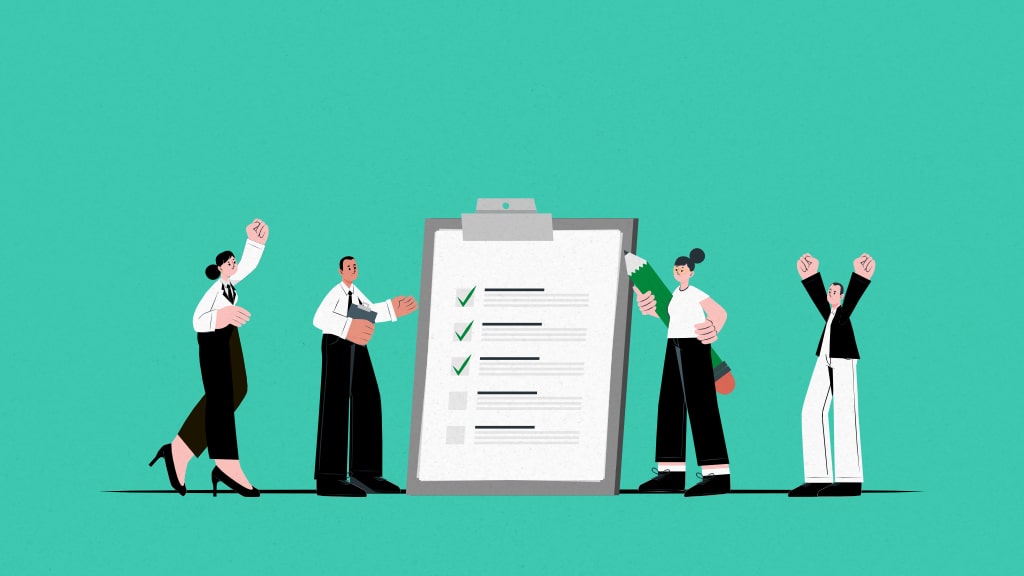
Introduction
The primary purpose of writing a project proposal is to secure funding, gain approval, or secure resources from the most important stakeholders of a project.
For that, you need to explain the following in simple terms in a project proposal:
- What do you want to do and what are your goals for the project?
- How are you going to achieve your goals?
- How are stakeholders going to benefit from the project?
- What do you want from stakeholders?
- How are you going to use the money and resources granted by stakeholders?
In this post, we will learn about all these about writing a perfect project proposal in 2024. We will look at different types of project proposals, a project proposal template, and a real-world example of a project proposal.
What is a project proposal?
A project proposal is a project management document that outlines a project’s objectives, timeline, budget, goals, and requirements.
It is primarily written for stakeholders to secure funding, gain approval, and secure resources. However, other types of project proposals are also sent to win projects from clients.
A project manager should have a good understanding of the project and its key stakeholders for writing an effective project proposal. It is because a manager needs to get into the heads of the project’s stakeholders to understand what they expect from a project and write an effective project proposal accordingly to ensure buy-in for the project.
Benefits of writing a strong project proposal
Writing a strong project proposal offers a surprising number of benefits beyond simply securing funding or approval. Here are five key benefits of writing an effective project proposal:
- Clearly defines the project to increase the chances of success
- Makes it easy for stakeholders to mutually understand the project
- Ensures everyone involved is on the same page about goals, roles, and expectations
- Helps identify potential roadblocks early for proactive planning of solutions
- It can attract funding, and talent, and even serve as a marketing tool
Difference between a project proposal, a project charter, and a project plan
It is important to note that a project proposal is different from a project charter and project plan. Let’s understand the difference between these terms.
Project proposal vs. project charter
A project charter is a formal document that outlines the project’s goals, objectives , and resource requirements for a shared understanding of the team. It can’t be created until the project proposal is approved. Whereas a project proposal is written during the initiation phase.
Project proposal vs. project plan
A project plan is a detailed guide that provides step-by-step instructions for executing, monitoring, and managing the approved project. It is created during the planning stage after the project charter and project scope is defined. Whereas, a project proposal is a persuasive tool for securing project approval and resources.
Read more: Project management plan – everything you need to know about
Project proposal types
Project proposals are of six different types. Each has a different goal. A manager may have to write a project proposal for external and internal stakeholders to run a project successfully. Therefore, it is important to know about the different types of project proposals.
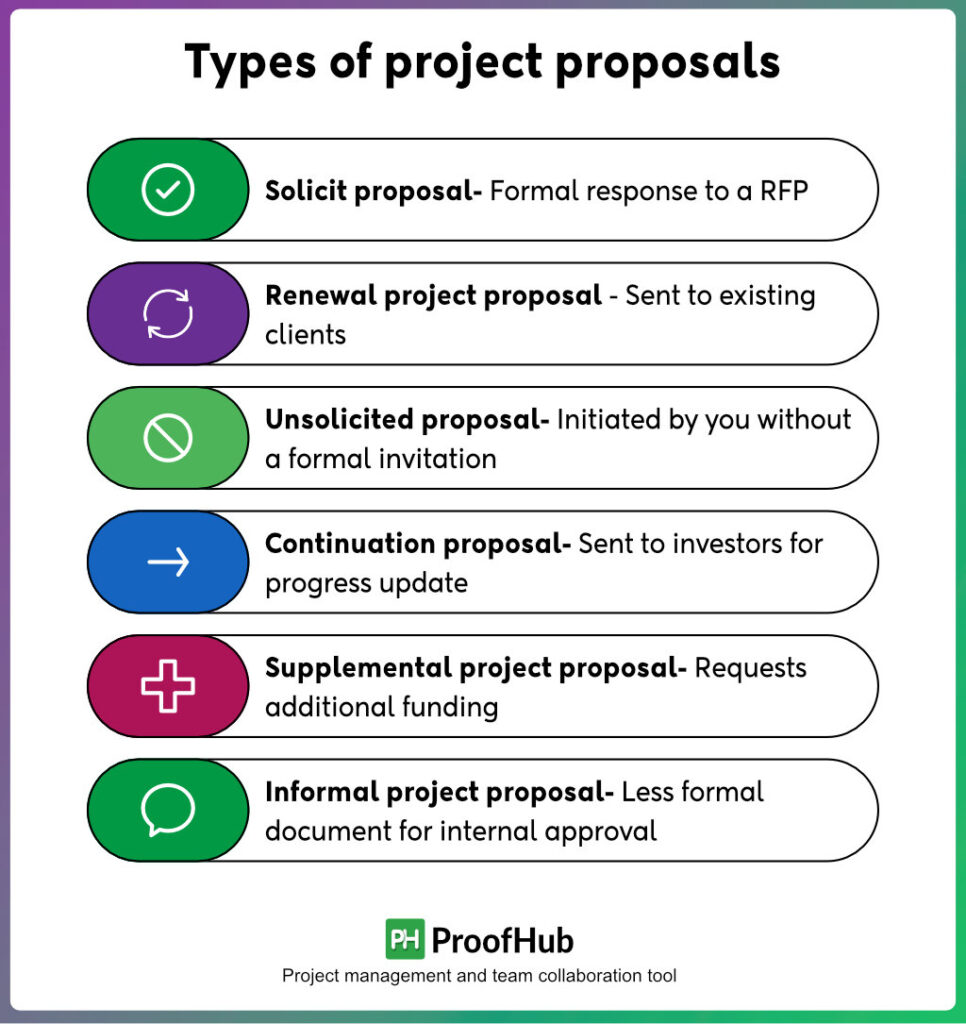
1. Solicited project proposal
A solicited project proposal is sent in response to a request for proposal (RFP). RFP is a document sent by a company to vendors to seek out resources required for a project. It includes the details of the scope of the work and the payment company pays for the resources.
RFP is sent to many vendors. Thus, while writing a solicited project proposal, you need to keep in mind that you may be competing against other vendors to secure a project. Thus, you need to keep your tone persuasive.
2. Unsolicited project proposal
This type of proposal is sent without having received a request for a proposal (RFP). A company has not sent a request for proposal to vendors but you know that the company is seeking resources from third-party vendors. You may or may not be competing against the other vendors in this type of proposal.
3. Informal project proposal
It is a type of project proposal that is created when a client makes an informal request for a project proposal from vendors. It means there is no formal RFP. Thus, the rules for writing a project proposal are less concrete. You can follow any format that can secure you a project.
4. Renewal project proposal
A project manager writes this type of proposal to existing clients to extend their services to the client. In this type of proposal, you focus on highlighting past achievements to secure a renewal for the future.
5. Continuation project proposal
The purpose of the continuation project proposal is to inform the client that the project is beginning and communicate the progress. You are not persuading the client with this type of proposal.
6. Supplemental project proposal
As the name suggests, this type of proposal is sent to the stakeholders who are already involved in a project to secure additional resources. The purpose is to convince the client to invest additional resources during the project execution phase.
How to write a winning project proposal?
You need to include certain elements in the project proposal to make sure it is good. Have a look at the steps to learn how to format a project proposal.
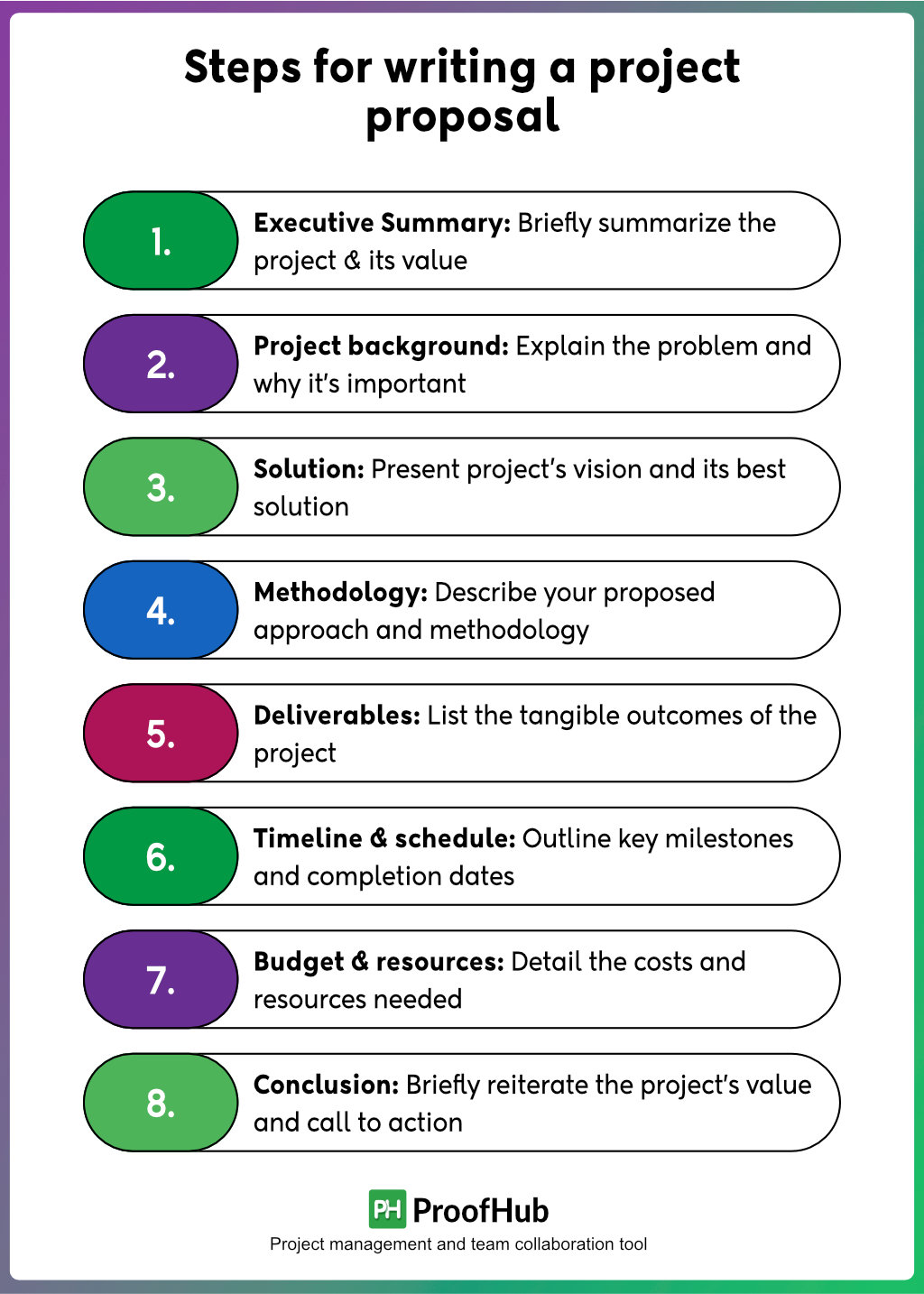
A. Pre-writing stage
The pre-writing stage is crucial for creating a compelling and successful project proposal. Here’s a breakdown of the key steps involved:
1. Understanding the audience
The first step is to identify decision-makers and understand the mindset of the audience for which you are writing a proposal. Thoroughly research the client’s needs, goals, and expectations. This includes understanding their industry, current challenges, and past projects.
Determine who will be reviewing and approving the proposal. This will help you adjust the tone, level of detail, and overall focus to cater to their expertise and interests. Tailor your proposal to directly address their specific concerns and priorities.
2. Project requirements gathering
To create an effective project proposal that has a higher chance of getting accepted, gather the project requirements. Usually, it is mentioned in the Request for Proposal (RFP) where specific requirements, evaluation criteria, submission deadlines, and any other instructions are provided.
If there is no RFP, schedule meetings or interviews with key stakeholders to gain a deeper understanding of the project requirements. This allows you to ask clarifying questions, gather feedback, and ensure your proposal aligns perfectly with their expectations.
3. Team brainstorming
Writing a project proposal is teamwork. Involve your team in brainstorming sessions to make a strong proposal. When a team is involved, it diversifies perspectives and expertise, leading to a more comprehensive and well-rounded proposal. Discuss the project goals, potential solutions, and resource needs with your team. Refine the proposal concept based on the collective knowledge and ensure everyone is aligned on the final approach.
B. Writing the proposal
1. start with writing an executive summary .
An executive summary is a concise overview of what a project is all about. It talks about the most important details or information of the project.
It primarily talks about the problem a project will solve, the solution a project will provide, and the benefits stakeholders will get from investing in this project.
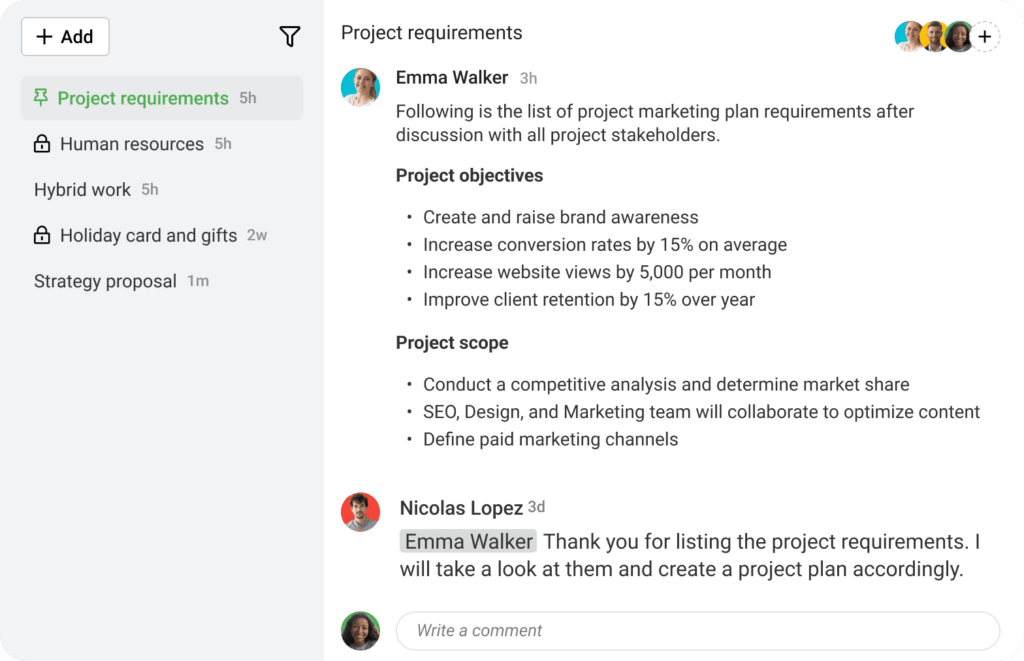
It is important to keep in mind to explain these items briefly as you are going to explain the problem and solution in detail later in your proposal.
The purpose of writing an executive summary is to pique the interest of the stakeholders in a project. It is like the elevator pitch of an entrepreneur whose purpose is to attract the stakeholders for further discussion.
2. Explain the problem in the project background
The project background is a one-page section that focuses on highlighting the opportunity by talking about the project problems you are going to solve. It talks about the problem and its history such as statistics, references, and start date.
It discusses what has been done so far to solve the problem by others or earlier projects. What is the current state of the problem, and how your project will focus on solving it?
This section indicates the opportunity and the next section of vision explains how you are going to seize the opportunity.
3. Project vision and solution
Project vision is the section where you present the solution to the problem. Vision statement defines your vision for the project, the solution you are going to work on, and how it will solve the problems.
This section tells what goals and objectives you are going to achieve from the project. Thus, it also acts as a north star or success criterion for your project.
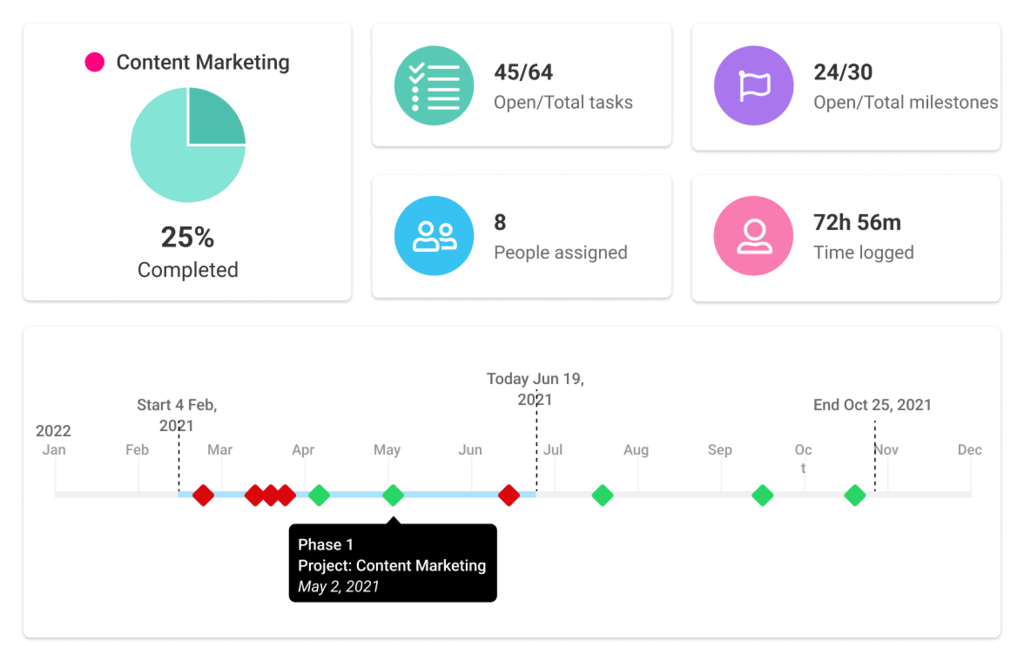
Now, stakeholders know what a project is all about; the problems, the solution, and the objectives. And they are interested to know how you will achieve the proposed objectives of a project.
The next sections of a project proposal talk about the project approach, scope, deliverables, milestones, budget, resources, and timeline.
Read more: Project objectives: learn how to write them for business growth
4. Project scope and deliverables
This section describes all the work items you need to work on a project. It involves breaking a large project into small tasks so that stakeholders can easily understand the project scope.
It also includes describing key milestones and project deliverables during the execution phase of your project life cycle.
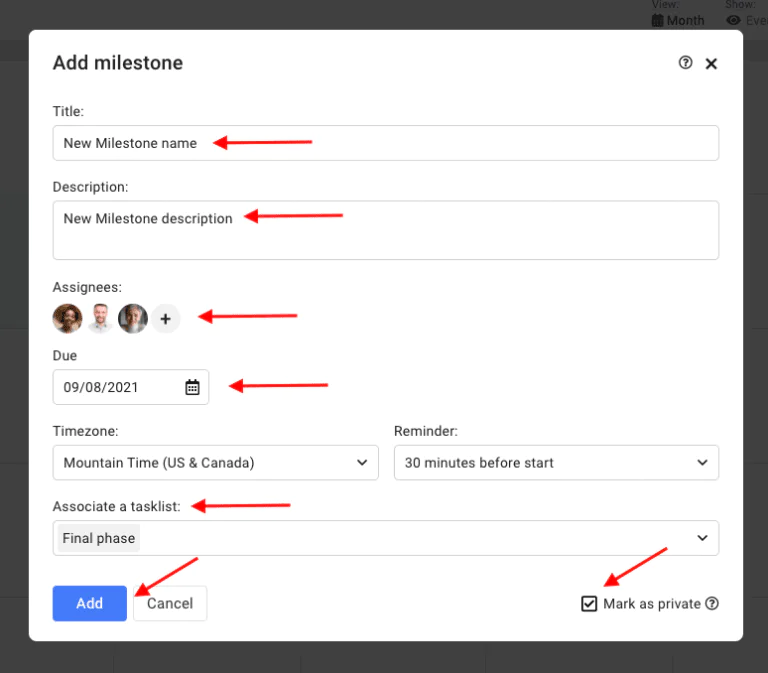
The purpose is to provide stakeholders with enough information to make decisions about funding and resources.
5. Project timeline
Project stakeholders have a clear idea about the scope of the project. But the very next question that comes to stakeholders’ minds is how much time a project will take to complete.
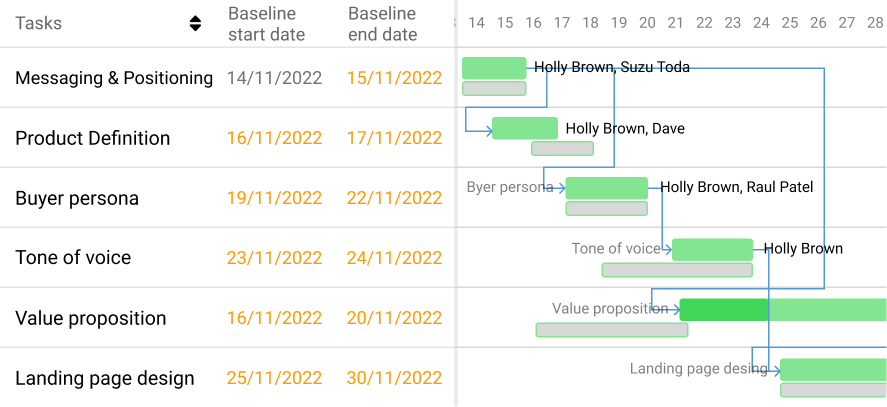
You need to propose an estimated timeline for the project describing when the key deliverables and milestones will be delivered and achieved.
6. Project methodology
With every project, the risks of cost, scope, time, and quality are associated. Thus, you need an effective project management approach to manage these risks.
In this section, you explain to stakeholders about the project approach you are going to use for project management . It includes defining project management methodology, tools, and governance for your project.
79% of teams worldwide use digital collaboration tools . The choice of your project management tool is going to influence how the project will be planned, executed, and managed and its potential risks are identified and mitigated successfully.
ProofHub is an all-in-one project management and team collaboration software that provides you with a centralized platform to collaborate with a team on a project proposal.
ProofHub strengthens your project proposal’s “Implementation Plan” by providing a platform to meticulously define tasks, assign roles, and track progress . Its work plan section allows for a detailed breakdown of the project with clear task dependencies and time estimates, visualized through a Gantt chart .
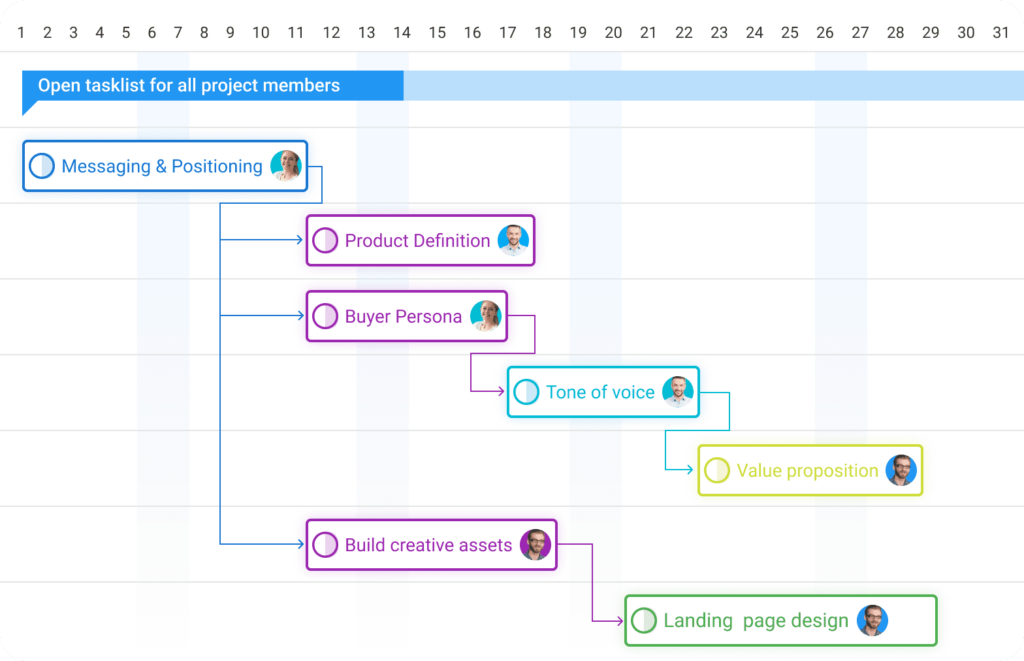
Team members can be assigned to specific tasks, ensuring accountability, while resource allocation demonstrates a well-planned approach.
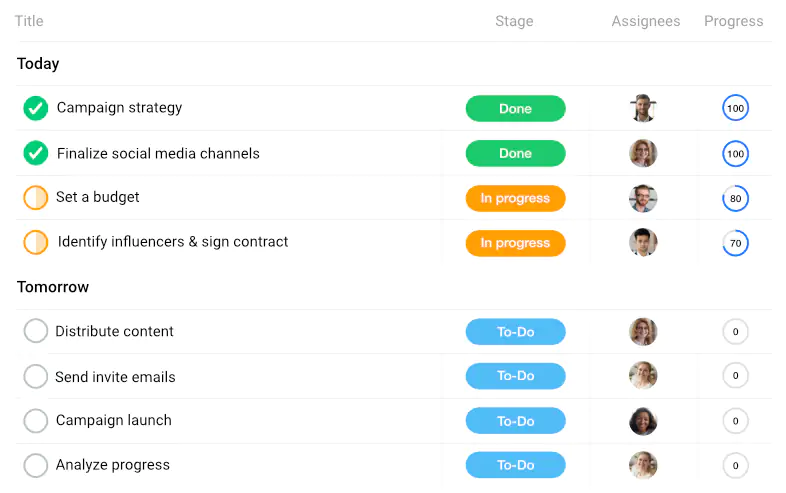
Real-time progress updates, collaborative discussions within tasks, and reporting capabilities showcase transparency and proactive management.
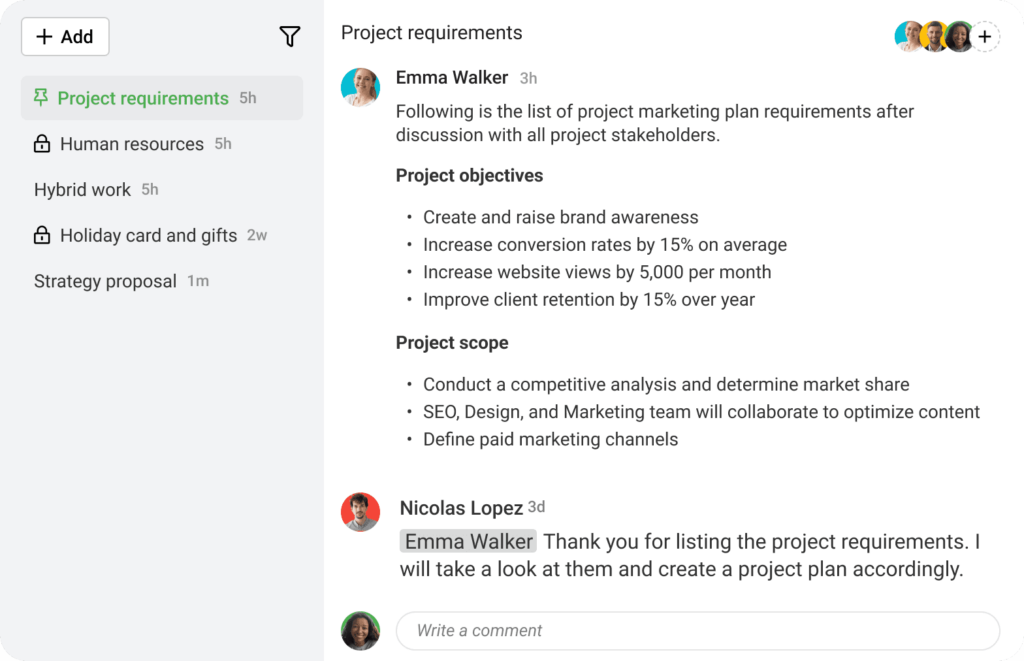
By incorporating ProofHub, your proposal presents a clear picture of efficient execution, giving the reader confidence in your ability to deliver the project successfully.
Learn more about ProofHub’s collaboration capabilities !
7. Project resource requirements
Project resource requirements talk about the resources you need to complete your project which includes materials, human resources, and technology. It is a key section that is crucial for the success of the project because every project needs resources to convert a plan into action.
This section of the project proposal briefly describes the project resources you need for the project and how you are going to utilize these resources.
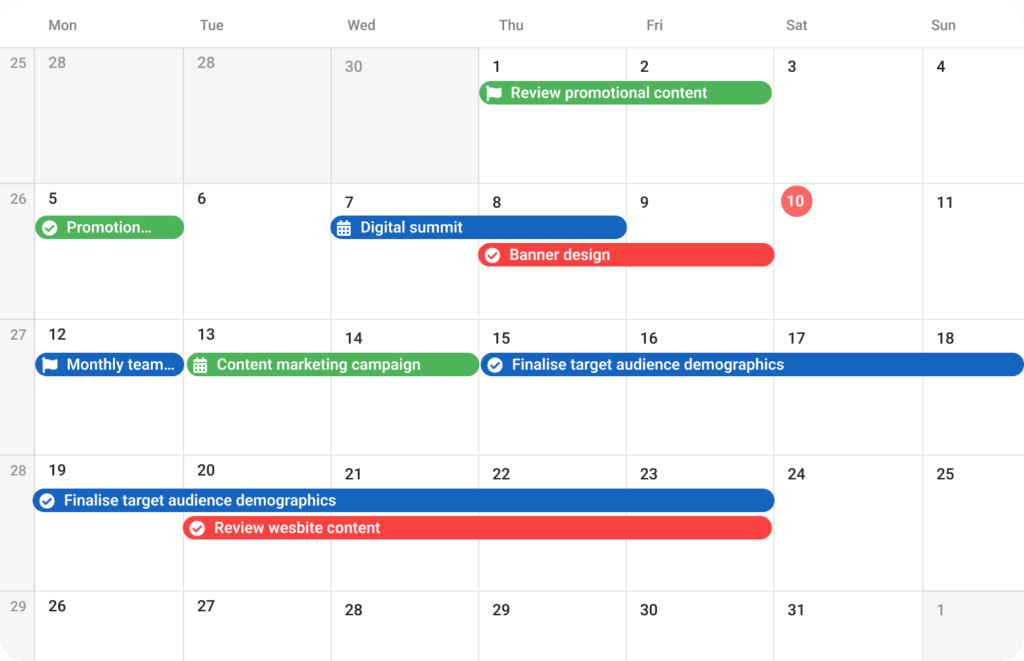
It does not explain the nitty gritty details of resource allocation. But, it gives a fair idea of why you need specific resources for your project and how these will be utilized.
Read more: 2024 guide to project resource management: processes, challenges & tools
8. Estimate project costs and budget
Project resources come at a price. Thus, in this section, you will define the project costs and create a project budget. It is the responsibility of a project manager to write this section in such a way that it covers all the project expenses.
At the same time, it also provides the opportunity for stakeholders to jump in and help you mitigate unexpected costs.
It also includes estimating project costs everything from the cost of project technology to team salaries and materials.
9. Closing statement
At this point of a project proposal, stakeholders have complete information about the project: scope, cost, time, objectives, and impact. You just have to briefly summarize the problem your project addresses and remind stakeholders about the benefits they will get from this project.
You can use cost-benefit analysis to demonstrate why your project is profitable. Thus, in this section, you wrap up your project proposal with a persuasive and confident conclusion to convince stakeholders to close the deal.
I hope these steps help you write a winning project proposal. Now, let’s have a look at some practical tips from experts to write a winning proposal.
Additional tips to write a perfect project proposal
Here are the five practical project proposal tips for writing a proposal:
- Clarity and conciseness: Do not use jargon or make your proposal overly complex. Keep it simple so that project sponsors can understand it easily.
- Strong value proposition: You want your project proposal to be accepted. Give strong emphasis on the benefits of your project and how it addresses the existing problems.
- Compelling visuals: Make your proposal compelling so that project sponsors read it. If it is not persuasive and visually interesting, project sponsors may not read it.
- Proofreading and editing: Do not make silly grammatical mistakes and fact check and proofread your proposal. Wherever required provide statistics to back your claims.
- Use collaboration tools: A project proposal involves explaining about project scope, cost, time, and resources. Use a project management tool like ProofHub to create a plan and collaborate with a team to create an effective project proposal.
Project proposal examples
A project proposal in project management is primarily sent to the stakeholders to secure funding, gain approvals, and request resources from stakeholders.
Here is a real-world example to get an idea of how to write a proposal for a project:
Project Proposal: Implementation of a CRM System to manage company customers, prospects, and leads
1. Executive
The Customer Success Manager at XYZ Corporation is proposing the implementation of a new Customer Relationship Management (CRM) system.
Currently, the company is using a legacy system that makes it difficult to manage data and ensure the alignment between the sales and marketing teams. It results in poor customer service to the customer and missed opportunities.
The new CRM system streamlines the company’s customer interactions, improves data management, and enhances overall customer satisfaction.
This results in enhanced customer relationships, improved operational efficiency, and increased business growth.
2. Background
- Lack of centralized data management system
- Lack of alignment between marketing and sales departments
- Not able to provide exceptional customer experience due to operational inefficiencies
3. Vision
- Implementing CRM to improve customer data management by centralizing all customer information into a single database
- Enhance communication and collaboration among sales, marketing, and customer service teams
- Increase customer satisfaction and retention through personalized and timely interaction
4. Project scope
- Researching and selecting a suitable CRM solution based on the specific needs and requirements of XYZ Corporation.
- Customizing the CRM system to align with the company’s business processes and workflows.
- Migrating existing customer data from legacy systems into the new CRM platform.
- Phase 1: Research and Selection (1 week)
- Phase 2: Customization and Configuration (2 weeks)
- Phase 3: Data Migration (1 week)
- Phase 4: Training and Adoption (2 weeks)
- Phase 5: Go-Live and Deployment (2 weeks)
5. Project management approach
Hybrid project management : Waterfall during the planning of each phase of the project and Agile during the implementation of the CRM.
6. Project resource and budget
The estimated budget for the CRM implementation project is $50,000, including software licensing fees, customization costs, training expenses, and implementation services.
7. Project risks and mitigation
- Potential resistance from employees toward adopting new technology
- Integration challenges with existing systems and applications:
Mitigation:
- Addressed through providing training sessions for employees to ensure hassle-free adoption of the CRM system.
- Managed through careful planning and coordination with IT vendors and stakeholders.
8. Conclusion
The implementation of a CRM system for XYZ Corporation enhances customer relationships, improves operational efficiency, and drives business growth. We seek approval from the executive management team to proceed with the implementation of the CRM system as outlined in this proposal.
Project management proposal template
Trying to manage a project without project management is like trying to play a football game without a game plan. – Karen Tate
A project management proposal template provides the framework and detailed proposal outlining to create a project proposal. It outlines the sections you need to include in a project proposal and the instructions in each section. By following the instructions in the template, you know how to make a project proposal, customized to your business needs.
Here is the project management proposal template:
1. Executive Summary
In this section, you will summarize the complete project proposal and add the most important details of the project.
Outline the following details in brief in the executive summary:
- Project background and vision
- Project goals and deliverables
- Project budget, timeframe, resource, and success criteria
2. Project Background
In this section, you will talk about the problem a project is going to solve or the business opportunity a project intends to grab. Explain it in-depth because it forms the basis of the project.
Here is what you need to include:
- Project history and stats of similar projects
- The basis upon which the project is created
3. Project vision
This section includes the project vision statement. You explain the solution to the project problem and define the goals of the project.
Here is what you need to do:
- Write a project vision
- Present a solution
- Write the SMART goals you want to achieve
4. Project plan
It includes multiple sections as below:
4.1 Project scope and deliverables
Project scope defines all the work you need to do to complete the project.
Project deliverable is something that is of the end-user or customer value.
4.2 Project timeline
Every project has a start and an end date. Similarly, there is a timeframe for each task and deliverable.
4.3 Project approach
Every project follows an approach to project management and uses project management tools. For example, construction projects follow the Waterfall methodology whereas software development projects follow the Agile methodology.
4.4 Project risks
A project risk is something that can impact the cost, time, and scope of the project.
List here all the project risks, likelihood, impact, mitigation plan, and risk owners in a table.
4.5 Project resource requirements
Project sponsors need to know about the details of the resources required to approve the budget for the Project Proposal.
Define the project resource requirements here in the table:
- Technology requirements
- Human resources requirements
- Material requirements
4.6 Project estimated cost and return on investment
A project sponsor wants to know the project costs and return on investments.
4.7 Project ownership and communication plan
This section includes the details of the key stakeholders of the project.
- Project sponsor: who owns the project
- Project customer: who the project is being delivered to
- Manager: who is responsible for managing the project and informing the status to stakeholders
5. Call to action
In this section, provide your contact details for the client to get in touch with any questions or allow the project sponsor to authorize the project if they are happy with the project proposal.
It is important to keep in mind the above-mentioned are the standard sections that are included in most project proposals. If you want to add some other elements to your project proposal, you can add the sections as per your needs to format a project proposal.
Create a winning project proposal with the right tool
A good project proposal convinces stakeholders why the project should be carried out. It should clearly describe project problems, project objectives, benefits for stakeholders, your requirements from stakeholders, and how you will utilize the secured resources. You need to have a good understanding of the project and project sponsors and stakeholders before writing a project proposal.
To create an effective project proposal, you need cross-collaboration between departments to gather key details and project management software to plan a project.
That’s where a feature-rich project management software, ProofHub, comes into play. It helps you with team collaboration and project planning for the project proposal. You can create a project plan using a Gantt chart , create tasks using task management software , and collaborate with the team using chat and a centralized file-sharing system .
Organize, manage, and collaborate seamlessly with ProofHub – All-in-one solution for projects, tasks, and teams
Related articles
- How to manage projects with a tool like ProofHub
- 10 Common project management challenges (and How to solve them)
- Project objectives: learn how to write them for business growth
- The 11 best project management software for your team
How long should a project proposal be?
A project proposal should not be too long. Ideally, a project proposal should take 1-2 pages but it also depends on the complexity of the project and the format you choose.
What section of a proposal presents a list of project costs?
Project costs are briefly covered in the Project Cost section. However, it depends on the template you choose. The detailed breakdown of the project costs is attached with the project proposal in the reference document.
What section of a proposal identifies the key issues and discusses the project goals?
Project background and project vision are the sections that talk about the key issues and project goals. However, it is explained in brief in the executive summary also.

- Share on LinkedIn
- Email this Page
- Share on Facebook
- Share on WhatsApp
Try ProofHub, our powerful project management and team collaboration software, for free !
No per user fee. No credit card required. Cancel anytime.

COMMENTS
Step 5: Final recommendations. In the last section/paragraph of your proposal, we need to conclude our proposal and make our final suggestions (after all that's the main reason for writing the proposal). Make sure that you include your final suggestions in this last paragraph as well as some persuasive language.
Students should work on functional language for evaluating and for making suggestions, and will need to be able to use a range of persuasive language. Source: Cambridge English C1 Advanced handbook for teachers. Proposals are part of the section section of the C1 Advanced Writing paper. While the essay task in the first section is mandatory ...
C1 writing. Are you a learner at C1 English level (advanced)? This section offers writing practice to help you write clear, well-structured texts about complex subjects. Texts include essays, proposals, articles, reports, reviews and emails. Each lesson has a preparation task, a model text with writing tips and three tasks to check your ...
Three steps to write the perfect Cambridge C1 Advanced report/proposal . Reports and proposals follow exactly the same structure. To keep things simple, let's just focus on an exam question for a report. You can practise analysing and writing a proposal later! Step 1: Plan it. Let's take a look at the exam question below.
The college principal invites students to send a proposal outlining any problems students may face when studying abroad and suggesting ways in which the course could address these problems. A decision can then be made about what to include on the course. Write your proposal in 220-260 words in an appropriate style.
In this video you can discover what makes the perfect proposal. We look at the best structure, each individual part as well as some good language you can use...
In this video we look at one of the Part 2 tasks of the Cambridge Advanced writing exam and how to write the proposal. You can find out more about this type ...
A CAE Proposal is a writing task that English students may need to answer in part 2 of the C1 Advanced (CAE) writing paper. Part 1 of the CAE writing paper is always an essay whereas part 2 consists of 3 different questions from a choice of 5 different types of writing. While there won't definitely be a proposal in the exam, there is at least a ...
Feedback in open class noting ideas on a shared document. Analyse the task: Student worksheet 1 Exercise 1. Students read the Part 2 task and answer the questions on their own or in pairs. Feedback: Display the task on the board. Nominate students to give answers, clarifying where necessary, underlining elements from the task:
Remember that Cambridge score writing on 4 things: Content, Communicative Achievement, Organisation, and Language. Content. For content they gave this student a 5 (out of 5). He did everything he was supposed to do. In the real world, the reader would understand the proposal and be able to make a decision.
Introduction. This proposal intends to outline how a digital version of the university newspaper, The Scallion, could function and aims to show that an online paper is viable for the future of the newspaper. It draws on the views of 3,000 students surveyed in May.
Writing - CAE C1. PAPER 2: WRITING consists of two different writing tasks, 220-260 words each, to be completed in 1 hour 30 minutes. Part 1 is a compulsory question. Candidates are expected to write an essay in response to a proposition to discuss, and accompanying text. In Part 2 candidates choose one task from a choice of three questions.
Writing: C1 A proposal for a digital newspaper Learn how to write a proposal. Before reading . Do the preparation task first. Then read the text and tips and do the exercises. Preparation task . Match the definitions (a-h) with the vocabulary (1 -8). Vocabulary . Definition
In the two parts of the C1 Advanced Writing paper, you have to show that you can write different types of text in English. Summary. Time allowed: 1 hour 30 minutes. Number of parts: 2. Number of questions: Part 1: one compulsory question. Part 2: one question from a choice of three.
To prepare for the C1 Advanced exam, learners should: Read widely to familiarise themselves with the conventions and styles of different types of writing (i.e. reports, proposals, reviews, letters and essays). Write 10-minute plans for a variety of questions in past papers, so that planning becomes automatic and quick.
Proposal are often structured include a similar manner to bericht and should be clearly organised under headings. The main difference between a report and an request is the into the latter were have to give recommendations on improving the situation. Click go see instructions to write C1 Modern (CAE) Proposal.
Write us a review explaining your opinions. Mention specific elements of the film which caught your attention, like the acting, visual effects or storyline. The best reviews will be published in the magazine. Write your review. Enhance your writing skills with Write & Improve's C1 Writing Part 2. Perfect for egxam preparation.
Level: N/A Score: N/A. Our app helps with preparing for the C1 Advanced (CAE) Cambridge exam by offering practice for all four English language skills: reading, writing, listening, and speaking.
Writing C1 Advanced: Proposal. Ahora vamos a ver las instrucciones de un proposal para C1 Advanced, un tipo de Writing nuevo que se introduce específicamente en este nivel. El propósito de este tipo de Writing es hacer una propuesta para algún tema sobre el que nos preguntan. Un tema muy típico es ser estudiante o trabajador de una facultad ...
The pre-writing stage is crucial for creating a compelling and successful project proposal. Here's a breakdown of the key steps involved: 1. Understanding the audience. The first step is to identify decision-makers and understand the mindset of the audience for which you are writing a proposal.